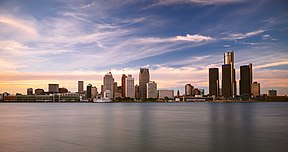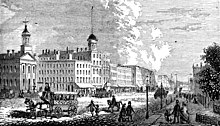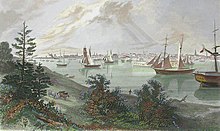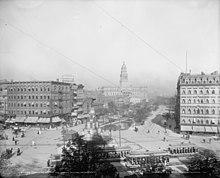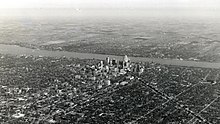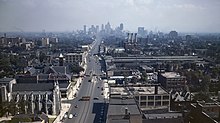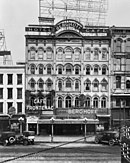Detroit
|
Detroit
|
|
|---|---|
|
|
|
| Etymology:French:détroit(strait) | |
| Nicknames:
The Motor City, Motown, The D, 313, D-Town, Renaissance City, The Town That Put The World on Wheels, Hockeytown, Detroit Rock City
|
|
| Motto(s):
Speramus Meliora; Resurget Cineribus
( Latin: We Hope For Better Things; It Shall Rise From the Ashes) |
|

Interactive map of Detroit
|
|
| Coordinates:42°19′53″N83°02′45″W / 42.33139°N 83.04583°W[1] | |
| Country | |
| State | |
| County | Wayne |
| Founded | July 24, 1701 |
| Incorporated | September 13, 1806 |
| Founded by | Antoine de la Mothe Cadillac&Alphonse de Tonty |
| Named for | Detroit River |
| Government | |
| • Type | Strong Mayor |
| • Body | Detroit City Council |
| •Mayor | Mike Duggan(D) |
| •Clerk | Janice Winfrey |
| • City council |
Members
|
| Area | |
| •City | 142.89 sq mi (370.09 km2) |
| • Land | 138.73 sq mi (359.31 km2) |
| • Water | 4.16 sq mi (10.78 km2) |
| • Urban | 1,284.8 sq mi (3,327.7 km2) |
| • Metro | 3,888.4 sq mi (10,071 km2) |
| Elevation | 656 ft (200 m) |
| Population | |
| •City | 639,111 |
| • Estimate
(2023)
[4]
|
633,218 |
| • Rank | 78thin North America 26thin the United States 1stin Michigan |
| • Density | 4,606.84/sq mi (1,778.71/km2) |
| •Urban | 3,776,890 (US:12th) |
| • Urban density | 2,939.6/sq mi (1,135.0/km2) |
| •Metro | 4,365,205 (US:14th) |
| Demonym | Detroiter |
| GDP | |
| • MSA | $305.412 billion (2022) |
| Time zone | UTC−5(EST) |
| • Summer (DST) | UTC−4(EDT) |
| ZIP Codes |
482XX
|
| Area code | 313 |
| FIPS code | 26-22000 |
| GNISfeature ID | 1617959[1] |
| Major airports | Detroit Metropolitan Airport,Coleman A. Young International Airport |
| Mass transit | Detroit Department of Transportation,Detroit People Mover,QLine |
| Website | detroitmi |
Detroit(/dɪˈtrɔɪt/,dih-TROYT;locally also/ˈdiːtrɔɪt/,DEE-troyt)[8]is themost populous cityin theU.S. stateofMichigan. It is the largest U.S. city on theCanadian borderand thecounty seatofWayne County. Detroit had a population of 639,111 at the2020 census,[9]making it the26th-most populous cityin the United States. TheMetro Detroitarea, home to 4.3 million people, is the second-largest in theMidwestafter theChicago metropolitan areaand the 14th-largest in the United States. A significant cultural center, Detroit is known for its contributions to music, art, architecture and design, in addition to its historical automotive background.[10][11]
In 1701,Antoine de la Mothe CadillacandAlphonse de TontyfoundedFort Pontchartrain du Détroit. During the late 19th and early 20th century, it became an important industrial hub at the center of theGreat Lakes region. The city's population rose to be the fourth-largest in the nation by 1920, afterNew York City,Chicago, andPhiladelphia, with the expansion of theautomotive industryin the early 20th century.[12]TheDetroit Riverbecame the busiest commercial hub in the world as it carried over 65 million tons of shipping commerce each year. In the mid-20th century, Detroit entered a state ofurban decaywhich has continued to the present, as a result of industrial restructuring, the loss of jobs in the auto industry, and rapidsuburbanization. Since reaching a peak of 1.85 million at the1950 census, Detroit's population has declined by more than 65 percent.[9]In 2013, Detroitbecame the largest U.S. city to file for bankruptcy, which it successfully exited in December 2014.[13]
Detroit is a port on the Detroit River, one of the four majorstraitsthat connect theGreat Lakessystem to theSt. Lawrence Seaway. The city anchors the third-largest regional economy in the Midwest and the 16th-largest in the United States.[14]Detroit is best known as the center of theU.S. automotive industry, and the "Big Three" auto manufacturers—General Motors,Ford, andStellantisNorth America (Chrysler)—are all headquartered in Metro Detroit.[15]TheDetroit Metropolitan Airportis among the most importanthub airportsin the United States. Detroit and its neighboring Canadian cityWindsorconstitute thesecond-busiest international crossingin North America, afterSan Diego–Tijuana.[16]
Detroit's diverse culturehas had both local and international influence, particularly inmusic, with the city giving rise to the genres ofMotownandtechnoand playing an important role in the development ofjazz,hip-hop,rock, andpunk. The rapid growth of Detroit in its boom years resulted in a globally unique stock ofarchitectural monumentsandhistoric places. Since the 2000s,conservationefforts have managed to save many architectural pieces and achieve several large-scalerevitalizations, including the restoration of several historictheatersand entertainment venues,high-riserenovations, new sports stadiums, and a riverfront revitalization project. Anincreasingly popular tourist destination, Detroit receives 16 million visitors per year.[17]In 2015, Detroit was named a "City of Design" byUNESCO, the first and only U.S. city to receive that designation.[18]
History
[edit]Toponymy
[edit]
Detroit is named after theDetroit River, connectingLake HuronwithLake Erie. The name comes from theFrenchworddétroitmeaning'strait'as the city was situated on a narrow passage of water linking the two lakes. The river was known asle détroit du Lac Ériéin French, which means'the strait of Lake Erie'.[19][20]In the historical context, the strait included theSt. Clair River,Lake St. Clair, and the Detroit River.[21][22]
Early settlement
[edit]
Kingdom of France1701–1760
Kingdom of Great Britain1760–1783
United States1783-1812
United Kingdom1812–1813
United States1813–present
Paleo-Indiansinhabited areas near Detroit as early as 11,000 years ago including the culture referred to as theMound Builders.[23]By the 17th century, the region was inhabited byHuron,Odawa,Potawatomi, andIroquoispeoples.[24]The area is known by theAnishinaabepeople asWaawiiyaataanong, translating to 'where the water curves around'.[25]
The first Europeans did not penetrate into the region and reach the straits of Detroit until Frenchmissionariesand traders worked their way around the Iroquois League, with whom they were at war in the 1630s.[26]The Huron andNeutral peopleheld the north side of Lake Erie until the 1650s, when the Iroquois pushed them and theErie peopleaway from the lake and itsbeaver-rich feeder streams in theBeaver Warsof 1649–1655.[26]By the 1670s, the war-weakened Iroquois laid claim to as far south as theOhio Rivervalley in northernKentuckyas hunting grounds,[26]and had absorbed many other Iroquoian peoples after defeating them in war.[26]For the next hundred years, virtually no British or French action was contemplated without consultation with the Iroquois or consideration of their likely response.[26]When theFrench and Indian Warevicted theKingdom of Francefrom Canada, it removed one barrier to American colonists migrating west.[27]
British negotiations with the Iroquois would both prove critical and lead to a Crown policy limiting settlements below the Great Lakes and west of theAlleghenies. Many colonial American would-be migrants resented this restraint and became supporters of theAmerican Revolution. The 1778 raids and resultant 1779 decisiveSullivan Expeditionreopened theOhio Countryto westward emigration, which began almost immediately. By 1800 white settlers were pouring westwards.[28]
French settlement
[edit]
On July 24, 1701, the French explorerAntoine de la Mothe Cadillac, with his lieutenantAlphonse de Tontyand more than a hundred other settlers, began constructing a small fort on the north bank of the Detroit River. Cadillac named the settlementFort Pontchartrain du Détroit,[29]afterLouis Phélypeaux, comte de Pontchartrain,Secretary of State of the NavyunderLouis XIV.[30]Sainte-Anne-de-Détroitwas founded on July 26 and is the second-oldest continuously operatingRoman Catholicparish in the United States.[31]France offered free land to colonists to attract families to Detroit; when it reached a population of 800 in 1765, it became the largest European settlement betweenMontrealandNew Orleans, both also French settlements, in the former colonies ofNew FranceandLa Louisiane, respectively.[32]
By 1773, after the addition ofAnglo-Americansettlers, the population of Detroit was 1,400. By 1778, its population reached 2,144 and it was the third-largest city in what was known as theProvince of Quebecsince the British takeover of French colonies following their victory in theSeven Years' War.[33]
The region's economy was based on the lucrativefur trade, in which numerous Native American people had important roles as trappers and traders. Today theflag of Detroitreflects its French colonial heritage. Descendants of the earliest French andFrench-Canadiansettlers formed a cohesive community, who gradually were superseded as the dominant population after more Anglo-American settlers arrived in the early 19th century with American westward migration. Living along the shores of Lake St. Clair and south toMonroeand downriver suburbs, the ethnic French Canadians of Detroit, also known asMuskrat Frenchin reference to the fur trade, remain a subculture in the region in the 21st century.[34][35]
During theFrench and Indian War(1754–63)—the North American front of theSeven Years' Warbetween Britain and France—British troops gained control of the settlement in 1760 and shortened its name to Detroit. Several regional Native American tribes, such as thePotowatomi,Ojibweand Huron, launchedPontiac's Warin 1763 andlaid siegetoFort Detroitbut failed to capture it. In defeat, France ceded its territory in North America east of the Mississippi to Britain following the war.[36]
Following theAmerican Revolutionary Warand the establishment of the United States as an independent country, Britain ceded Detroit along with other territories in the area under theJay Treatywhich established the northern border with its colony of Canada.[37]TheGreat Fire of 1805destroyed most of the Detroit settlement, which had primarily buildings made of wood. One stone fort, a river warehouse, and brick chimneys of former wooden homes were the sole structures to survive.[38]Of the 600 Detroit residents in this area, none died in the fire.[39]The legacy of the fire of 1805 lives on in many aspects of modern Detroit heritage. The cities motto, "Speramus Meliora; Resurget Cineribus" was coined byFather Gabriel Richardas he looked out at the ruins of the city in the fire's aftermath.[40][41]The city seal, designed by J.O. Lewis in 1827, directly depicts the Great Fire of 1805. Two women stand in the foreground while on the left, the city burns in the background and a woman weeps over the destruction. The woman on the right consoles her by gesturing to a new city that will rise in its place.[42]The city seal also forms the center of the flag of the city.
19th century
[edit]From 1805 to 1847, Detroit was the capital of Michiganas a territoryand as a state.William Hull, the United States commander at Detroit, surrendered without a fight to British troops and their Native American allies during theWar of 1812in thesiege of Detroit, believing his forces were vastly outnumbered. TheBattle of Frenchtownwas part of a U.S. effort to retake the city, and U.S. troops suffered their highest fatalities of any battle in the war. This battle is commemorated atRiver Raisin National Battlefield Parksouth of Detroit inMonroe County. Detroit was recaptured by the United States later that year.[43]
The settlement was incorporated as a city in 1815.[44]As the city expanded, a radial geometric street plan developed by Chief JusticeAugustus B. Woodwardwas followed, featuring grand boulevards as inParis.[45]In 1817, Woodward went on to establish theCatholepistemiad, or University of Michigania in the city. Intended to be a centralized system of schools, libraries, and other cultural and scientific institutions for the Michigan Territory, the Catholepistemiad evolved into the modern University of Michigan.
Prior to theAmerican Civil War, the city's access to the Canada–US border made it a key stop forrefugee slavesgaining freedom in the North along theUnderground Railroad. Many went across the Detroit River to Canada to escape pursuit by slave catchers.[46][44]An estimated 20,000 to 30,000 African-American refugees settled in Canada.[47]George DeBaptistewas considered to be the "president" of the Detroit Underground Railroad,William Lambertthe "vice president" or "secretary", andLaura Smith Havilandthe "superintendent".[48]
Numerous men from Detroit volunteered to fight for theUnionduring the Civil War, including the 24th Michigan Infantry Regiment. It was part of theIron Brigade, which fought with distinction and suffered 82% casualties at theBattle of Gettysburgin 1863. When the First Volunteer Infantry Regiment arrived to fortifyWashington, D.C., PresidentAbraham Lincolnis quoted as saying, "Thank God for Michigan!"George Armstrong Custerled theMichigan Brigadeduring the Civil War and called them the "Wolverines".[49]
During the late 19th century, wealthy industry and shipping magnates commissioned the design and construction of severalGilded Agemansions east and west of the current downtown, along the major avenues of the Woodward plan. Most notable among them was theDavid Whitney Houseat 4421Woodward Avenue, and the grand avenue became a favored address for mansions. During this period, some referred to Detroit as the "Paris of the West" for its architecture, grand avenues in the Paris style, and for Washington Boulevard, recently electrified byThomas Edison.[44]The city had grown steadily from the 1830s with the rise of shipping, shipbuilding, and manufacturing industries. Strategically located along the Great Lakes waterway, Detroit emerged as a major port and transportation hub.[citation needed]
In 1896, a thriving carriage trade promptedHenry Fordto build his first automobile in a rented workshop on Mack Avenue. During this growth period, Detroit expanded its borders by annexing all or part of several surrounding villages and townships.[50]
20th century
[edit]In 1903, Henry Ford founded theFord Motor Company. Ford's manufacturing—and those of automotive pioneersWilliam C. Durant,HoraceandJohnDodge,JamesandWilliamPackard, andWalter Chrysler—established Detroit's status in the early 20th century as the world's automotive capital.[44]The growth of the auto industry was reflected by changes in businesses throughout the Midwest and nation, with the development of garages to service vehicles and gas stations, as well as factories for parts and tires.[citation needed]Because of the booming auto industry, Detroit became the fourth-largest city in the nation by 1920, followingNew York City,Chicago, andPhiladelphia.[51]
In 1907, the Detroit River carried 67,292,504 tons of shipping commerce through Detroit to locations all over the world. For comparison, London shipped 18,727,230 tons, andNew Yorkshipped 20,390,953 tons. The river was dubbed "the Greatest Commercial Artery on Earth" byThe Detroit Newsin 1908. Theprohibition of alcoholfrom 1920 to 1933 resulted in the Detroit River becoming a major conduit for smuggling of illegal Canadian spirits.[12]
With the rapid growth of industrial workers in the auto factories,labor unionssuch as theAmerican Federation of Laborand theUnited Auto Workers(UAW) fought to organize workers to gain them better working conditions and wages. They initiatedstrikesand other tactics in support of improvements such asthe 8-hour day/40-hour work week, increased wages, greater benefits, and improvedworking conditions. The labor activism during those years increased the influence of union leaders in the city such asJimmy Hoffaof theTeamstersandWalter Reutherof the UAW.[52]
Detroit, like many places in the United States, developed racial conflict and discrimination in the 20th century following the rapid demographic changes as hundreds of thousands of new workers were attracted to the industrial city. TheGreat Migrationbrought rural blacks from the South; they were outnumbered by southern whites who also migrated to the city. Immigration brought southern and eastern Europeans of Catholic and Jewish faith; these new groups competed with native-born whites for jobs and housing in the booming city.[citation needed]
Detroit was one of the major Midwest cities that was a site for the dramatic urban revival of theKu Klux Klan(KKK) beginning in 1915. "By the 1920s the city had become a stronghold of the KKK", whose members primarily opposed Catholic and Jewish immigrants but also practiced discrimination against Black Americans.[53]Even after the decline of the KKK in the late 1920s, theBlack Legion, a secret vigilante group, was active in the Detroit area in the 1930s. One-third of its estimated 20,000 to 30,000 members in Michigan were based in the city. It was defeated after numerous prosecutions following the kidnapping and murder in 1936 of Charles Poole, a Catholic organizer with the federalWorks Progress Administration. Some 49 men of the Black Legion were convicted of numerous crimes, with many sentenced to life in prison for murder.[54]
By 1940, 80% of Detroit deeds containedrestrictive covenantsprohibiting African Americans from buying houses they could afford. These discriminatory tactics were successful as a majority of black people in Detroit resorted to living in all-black neighborhoods such asBlack Bottomand Paradise Valley. At this time, white people still made up about 90.4% of the city's population.[55]White residents attacked black homes: breaking windows, starting fires, and detonating bombs.[56][57]
In the 1940s the world's "first urban depressed freeway" ever built,the Davison,[58]was constructed. During World War II, the government encouraged retooling of theAmerican automobile industryin support of theAllied powers, leading to Detroit's key role in the AmericanArsenal of Democracy.[59]Jobs expanded so rapidly due to the defense buildup in World War II that 400,000 people migrated to the city from 1941 to 1943, including 50,000 blacks in the second wave of the Great Migration, and 350,000 whites, many of them from the South. Whites, including ethnic Europeans, feared black competition for jobs and scarce housing. The federal government prohibited discrimination in defense work, but when in June 1943 Packard promoted three black people to work next to whites on its assembly lines, 25,000 white workers walked off the job.[60]The1943 Detroit race riottook place in June, three weeks after thePackard plantprotest, beginning with an altercation atBelle Isle. A total of 34 people were killed, 25 of them black and most at the hands of the white police force, while 433 were wounded (75% of them black), and property valued at $2 million (worth $30.4 million in 2020) was destroyed. Rioters moved through the city, and young whites traveled across town to attack more settled blacks in their neighborhood ofParadise Valley.[61][62]
Postwar era
[edit]Industrial mergers in the 1950s, especially in the automobile sector, increasedoligopolyin the American auto industry. Detroit manufacturers such as Packard andHudsonmerged into other companies and eventually disappeared. At its peak population of 1,849,568, in the1950 Census, the city was the fifth-largest in the United States.[63]
In this postwar era, the auto industry continued to create opportunities for many African Americans from the South, who continued with their Great Migration to Detroit and other northern and western cities to escape the strictJim Crow lawsand racial discrimination policies of the South. Postwar Detroit was a prosperous industrial center of mass production. The auto industry comprised about 60% of all industry in the city, allowing space for a plethora of separate booming businesses including stove making, brewing, furniture building, oil refineries, pharmaceutical manufacturing, and more. The expansion of jobs created unique opportunities for black Americans, who saw novel high employment rates: there was a 103% increase in the number of blacks employed in postwar Detroit. Black Americans who immigrated to northern industrial cities from the south still faced intense racial discrimination in the employment sector. Racial discrimination kept the workforce and better jobs predominantly white, while many black Detroiters held lower-paying factory jobs. Despite changes in demographics as the city's black population expanded, Detroit's police force, fire department, and other city jobs continued to be held by predominantly white residents. This created an unbalanced racial power dynamic.[64]
Unequal opportunities in employment resulted in unequal housing opportunities for the majority of the black community: with overall lower incomes and facing the backlash of discriminatory housing policies, the black community was limited to lower cost, lower quality housing in the city. The surge in the black population augmented the strain on housing scarcity. The livable areas available to the black community were limited, and as a result, families often crowded together in unsanitary, unsafe, and illegal quarters. Such discrimination became increasingly evident in the policies ofredliningimplemented by banks and federal housing groups, which almost completely restricted the ability of blacks to improve their housing and encouraged white people to guard the racial divide that defined their neighborhoods. As a result, black people were often denied bank loans to obtain better housing, and interest rates and rents were unfairly inflated to prevent their moving into white neighborhoods. White residents and political leaders largely opposed the influx of black Detroiters to white neighborhoods, believing that their presence would lead to neighborhood deterioration. This perpetuated a cyclical exclusionary process that marginalized the agency of black Detroiters by trapping them in the unhealthiest, least safe areas of the city.[64]
As in other major American citiesin the postwar era,modernistplanning ideology drove the construction of a federally subsidized, extensive highway and freeway system around Detroit, and pent-up demand for new housing stimulated suburbanization; highways made commuting by car for higher-income residents easier. However, this construction had negative implications for many lower-income urban residents. Highways were constructed through and completely demolished neighborhoods of poor residents and black communities who had less political power to oppose them. The neighborhoods were mostly low income, considered blighted, or made up of older housing where investment had been lacking due to racial redlining, so the highways were presented as a kind of urban renewal. These neighborhoods (such as Black Bottom and Paradise Valley) were extremely important to the black communities of Detroit, providing spaces for independent black businesses and social/cultural organizations. Their destruction displaced residents with little consideration of the effects of breaking up functioning neighborhoods and businesses.[64]
In 1956, Detroit's last heavily usedelectric streetcar line, which traveled along the length of Woodward Avenue, was removed and replaced with gas-powered buses. It was the last line of what had once been a 534-mile network of electric streetcars. In 1941, at peak times, a streetcar ran on Woodward Avenue every 60 seconds.[65][66]
All of these changes in the area's transportation system favored low-density, auto-oriented development rather than high-density urban development. Industry also moved to the suburbs, seeking large plots of land for single-story factories. By the 21st century, the metro Detroit area had developed as one of the mostsprawlingjob markets in the United States; combined with poor public transport, this resulted in many new jobs being beyond the reach of urban low-income workers.[67]
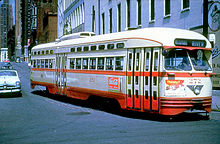
In 1950, the city held about one-third of the state's population. Over the next 60 years, the city's population declined to less than 10 percent of the state's population. During the same time period, the sprawling metropolitan area grew to contain more than half of Michigan's population.[44]The shift of population and jobs eroded Detroit's tax base.[citation needed]
In June 1963, Rev.Martin Luther King Jr.gave amajor speechas part of a civil rights march in Detroit that foreshadowed his "I Have a Dream" speech in Washington, D.C., two months later. While thecivil rights movementgained significant federal civil rights laws in 1964 and 1965, longstanding inequities resulted in confrontations between the police and inner-city black youth who wanted change.[68]
I have a dream this afternoon that my four little children, that my four little children will not come up in the same young days that I came up within, but they will be judged on the basis of the content of their character, not the color of their skin ... I have a dream this evening that one day we will recognize the words of Jefferson that "all men are created equal, that they are endowed by their Creator with certain unalienable Rights, that among these are Life, Liberty and the pursuit of Happiness." I have a dream ...
—Martin Luther King Jr. (June 1963 Speech at theGreat March on Detroit)[69]
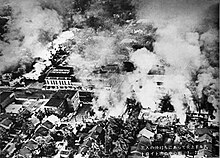
Longstanding tensions in Detroit culminated in theTwelfth Street riotin July 1967. GovernorGeorge W. Romneyordered theMichigan National Guardinto Detroit, and PresidentLyndon B. Johnsonsent in U.S. Army troops. The result was 43 dead, 467 injured, over 7,200 arrests, and more than 2,000 buildings destroyed, mostly in black residential and business areas. Thousands of small businesses closed permanently or relocated to safer neighborhoods. The affected district lay in ruins for decades.[70]According to theChicago Tribune, it was the 3rd most costly riot in the United States.[71]
On August 18, 1970, theNAACPfiled suit against Michigan state officials, including GovernorWilliam Milliken, chargingde factopublic school segregation. The NAACP argued that although schools were not legally segregated, the city of Detroit and its surrounding counties had enacted policies to maintainracial segregationin public schools. The NAACP also suggested a direct relationship between unfair housing practices and educational segregation, as the composition of students in the schools followed segregated neighborhoods.[72]The District Court held all levels of government accountable for the segregation in its ruling. TheSixth Circuit Court of Appealsaffirmed some of the decision, holding that it was the state's responsibility tointegrateacross the segregated metropolitan area.[73]The U.S. Supreme Court took up the case February 27, 1974.[72]The subsequentMilliken v. Bradleydecisionhad nationwide influence. In a narrow decision, the Supreme Court found schools were a subject of local control, and suburbs could not be forced to aid with the desegregation of the city's school district.[74]
"Milliken was perhaps the greatest missed opportunity of that period", saidMyron Orfield, professor of law at theUniversity of Minnesota Law School. "Had that gone the other way, it would have opened the door to fixing nearly all of Detroit's current problems."[75]John Mogk, a professor of law and an expert in urban planning atWayne State University Law Schoolin Detroit, says,
Everybody thinks that it was the riots [in 1967] that caused the white families to leave. Some people were leaving at that time but, really, it was after Milliken that you saw mass flight to the suburbs. If the case had gone the other way, it is likely that Detroit would not have experienced the steep decline in its tax base that has occurred since then.[75]
1970s and decline
[edit]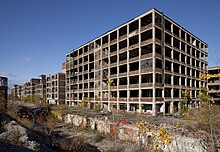
In November 1973, the city electedColeman Youngas its first black mayor. After taking office, Young emphasized increasing racial diversity in the police department, which was predominantly white.[76]Young also worked to improve Detroit's transportation system, but the tension between Young and his suburban counterparts over regional matters was problematic throughout his mayoral term.
In 1976, the federal government offered $600 million (~$2.5 billion in 2023) for building a regionalrapid transitsystem, under a single regional authority.[77]But the inability of Detroit and its suburban neighbors to solve conflicts over transit planning resulted in the region losing the majority of funding for rapid transit.[citation needed]The city then moved forward with construction of the elevated downtown circulator portion of the system, which became known as theDetroit People Mover.[78]
The gasoline crises of1973and1979affected auto industry. Buyers chose smaller, more fuel-efficient cars made by foreign makers as the price of gas rose. Efforts to revive the city were stymied by the struggles of the auto industry, as their sales and market share declined. Automakers laid off thousands of employees and closed plants in the city, further eroding the tax base. To counteract this, the city usedeminent domainto build two large new auto assembly plants in the city.[79]
Young sought to revive the city by seeking to increase investment in the city's declining downtown. TheRenaissance Center, a mixed-use office and retail complex, opened in 1977. This group of skyscrapers was an attempt to keep businesses in downtown.[44][80][81]Young also gave city support to other large developments to attract middle and upper-class residents back to the city. Despite the Renaissance Center and other projects, the downtown area continued to lose businesses to theautomobile-dependentsuburbs. Major stores and hotels closed, and many large office buildings went vacant. Young was criticized for being too focused on downtown development and not doing enough to lower the city's high crime rate and improve city services to residents.[citation needed]
High unemployment was compounded bymiddle-class flightto the suburbs, and some residents leaving the state to find work. The result for the city was a higher proportion of poor in its population, reduced tax base, depressed property values, abandoned buildings, abandoned neighborhoods, and high crime rates.[82]
On August 16, 1987,Northwest Airlines Flight 255crashed near Detroit Metro airport, killing all but one of the 155 people on board, as well as two people on the ground.[83]
In 1993, Young retired as Detroit's longest-serving mayor, deciding not to seek a sixth term, withDennis Archersucceeding him. Archer prioritized downtown development, easing tensions with its suburban neighbors. A referendum to allow casino gambling in the city passed in 1996; several temporary casino facilities opened in 1999, and permanent downtown casinos with hotels opened in 2007–08.[84]
21st century
[edit]Campus Martius, a reconfiguration of downtown's main intersection as a new park, was opened in 2004. The park has been cited as one of the best public spaces in the United States.[85][86][87]In 2001, the first portion of theInternational Riverfrontredevelopment was completed as a part of the city's 300th-anniversary celebration.[88]
In September 2008, MayorKwame Kilpatrick(who had served for six years) resigned following felony convictions. In 2013, Kilpatrick was convicted on 24 federal felony counts, includingmail fraud,wire fraud, andracketeering,[89]and was sentenced to 28 years in federal prison.[90]The former mayor's activities cost the city an estimated $20 million.[91]Roughly half of the owners of Detroit's 305,000 properties failed to pay their 2011 tax bills, resulting in about $246 million (~$329 million in 2023) in taxes and fees going uncollected, nearly half of which was due to Detroit. The rest of the money would have been earmarked for Wayne County, Detroit Public Schools, and the library system.[92]

The city's financial crisis resulted in Michigan taking over administrative control of its government.[93]GovernorRick Snyderdeclared afinancial emergencyin March 2013, stating the city had a $327 million budget deficit and faced more than $14 billion in long-term debt. It had been making ends meet on a month-to-month basis with the help of bond money held in a state escrow account and had instituted mandatory unpaid days off for many city workers. Those troubles, along with underfunded city services, such as police and fire departments, and ineffective turnaround plans from Mayor Bing and the City Council[94]led the state of Michigan to appoint an emergency manager for Detroit. On June 14, 2013, Detroit defaulted on $2.5 billion of debt by withholding $39.7 million in interest payments, while Emergency ManagerKevyn Orrmet with bondholders and other creditors in an attempt to restructure the city's $18.5 billion debt and avoid bankruptcy.[95]On July 18, 2013, Detroit became the largest U.S. city tofile for bankruptcy.[96]It was declared bankrupt by U.S. District Court on December 3, with its $18.5 billion debt.[97]On November 7, 2014, the city's plan for exiting bankruptcy was approved. On December 11 the city officially exited bankruptcy. The plan allowed the city to eliminate $7 billion in debt and invest $1.7 billion into improved city services.[98]
One way the city obtained this money was through theDetroit Institute of Arts(DIA). Holding over 60,000 pieces of art worth billions of dollars, some saw it as the key to funding this investment. The city came up with a plan to monetize the art and sell it, leading to the DIA becoming a private organization. After months of legal battles, the city finally got hundreds of millions of dollars towards funding a new Detroit.[99]
One of the largest post-bankruptcy efforts to improve city services has been to fix the city's broken street lighting system. At one time it was estimated that 40% of lights were not working, which resulted in public safety issues and abandonment of housing. The plan called for replacing outdatedhigh-pressure sodium lightswith 65,000 LED lights. Construction began in late 2014 and finished in December 2016; Detroit is the largest U.S. city with all LED street lighting.[100]
In the 2010s, several initiatives were taken by Detroit's citizens and new residents to improve the cityscape by renovating and revitalizing neighborhoods. Such projects include volunteer renovation groups[101]and variousurban gardeningmovements.[102]Miles of associated parks and landscaping have been completed in recent years. In 2011, the Port Authority Passenger Terminal opened, with the riverwalk connecting Hart Plaza to the Renaissance Center.[81]

One symbol of the city's decades-long decline, theMichigan Central Station, was long vacant. The city renovated it with new windows, elevators and facilities, completing the work in December 2015.[104]In 2018, Ford Motor Company purchased the building and plans to use it for mobility testing with a potential return of train service.[105]Several other landmark buildings have been privately renovated and adapted ascondominiums, hotels, offices, or for cultural uses. Detroit was mentioned as a city of renaissance and has reversed many of the trends of the prior decades.[106][107]
The city has seen a rise ingentrification.[108]In downtown, for example, the construction ofLittle Caesars Arenabrought with it high class shops and restaurants along Woodward Avenue. Office tower and condominium construction has led to an influx of wealthy families but also a displacement of long-time residents and culture.[109][110]Areas outside of downtown and other recently revived areas have an average household income of about 25% less than the gentrified areas, a gap that is continuing to grow.[111]Rents and cost of living in these gentrified areas rise every year, pushing minorities and the poor out, causing more and more racial disparity and separation in the city. In 2019, the cost of a one-bedroom loft in Rivertown reached $300,000 (~$352,668 in 2023), with a five-year sale price change of over 500% and average income rising by 18%.[112]
Geography
[edit]
Metropolitan area
[edit]Detroit is the center of a three-county urban area (with a population of 3,734,090 within an area of 1,337 square miles (3,460 km2) according to the2010 United States Census), six-countymetropolitan statistical area(population of 5,322,219 in an area of 3,913 square miles [10,130 km2] as of the 2010 census), and a nine-countyCombined Statistical Area(population of 5.3 million within 5,814 square miles [15,060 km2] as of 2010[update]).[113][114][115]
Topography
[edit]According to theU.S. Census Bureau, the city has a total area of 142.87 square miles (370.03 km2), of which 138.75 square miles (359.36 km2) is land and 4.12 square miles (10.67 km2) is water.[116]Detroit is the principal city inMetro DetroitandSoutheast Michigan. It is situated in theMidwestern United Statesand theGreat Lakes region.[117]
TheDetroit River International Wildlife Refugeis the only internationalwildlife preservein North America and is uniquely located in the heart of a major metropolitan area. The refuge includes islands, coastal wetlands, marshes, shoals, and waterfront lands along 48 miles (77 km) of the Detroit River and western Lake Erie shoreline.[118]
The city slopes gently from the northwest to southeast on atill plaincomposed largely of glacial and lake clay. The most notable topographical feature in the city is the Detroit Moraine, a broad clay ridge on which the older portions of Detroit and Windsor are located, rising approximately 62 feet (19 m) above the river at its highest point.[119]The highest elevation in the city is directly north of Gorham Playground on the northwest side approximately three blocks south of8 Mile Road, at a height of 675 to 680 feet (206 to 207 m).[120]Detroit's lowest elevation is along the Detroit River, at a surface height of 572 feet (174 m).[121]
Belle Isle Parkis a 982-acre (1.534 sq mi; 397 ha) island park in the Detroit River, between Detroit andWindsor, Ontario. It is connected to the mainland by theMacArthur Bridge. Belle Isle Park contains such attractions as theJames Scott Memorial Fountain, theBelle Isle Conservatory, theDetroit Yacht Clubon an adjacent island, a half-mile (800 m) beach, a golf course, a nature center, monuments, and gardens. Both the Detroit and Windsor skylines can be viewed at the island's Sunset Point.[122]
Three road systems cross the city: the original French template, with avenues radiating from the waterfront, and truenorth–south roadsbased on theNorthwest Ordinancetownship system. The city is north of Windsor, Ontario. Detroit is the only major city along the Canada–U.S. border in which one travels south in order to cross into Canada.[123]
Detroit has four border crossings: theAmbassador Bridgeand theDetroit–Windsor tunnelprovide motor vehicle thoroughfares, with theMichigan Central Railway Tunnelproviding railroad access to and from Canada. The fourth border crossing is theDetroit–Windsor Truck Ferry, near the Windsor Salt Mine andZug Island. Near Zug Island, the southwest part of the city was developed over a 1,500-acre (610 ha) salt mine that is 1,100 feet (340 m) below the surface. TheDetroit salt minerun by the Detroit Salt Company has over 100 miles (160 km) of roads within.[124][125]
Cityscape
[edit]Architecture
[edit]

Seen in panorama, Detroit's waterfront shows a variety of architectural styles. ThepostmodernNeo-Gothicspires ofAlly Detroit Centerwere designed to refer to the city'sArt Decoskyscrapers. Together with theRenaissance Center, these buildings form a distinctive and recognizable skyline. Examples of the Art Deco style include theGuardian BuildingandPenobscot Buildingdowntown, as well as theFisher BuildingandCadillac Placein theNew Centerarea nearWayne State University. Among the city's prominent structures are United States' largestFox Theatre, theDetroit Opera House, and theDetroit Institute of Arts, all built in the early 20th century.[126][127]
While theDowntownand New Center areas contain high-rise buildings, the majority of the surrounding city consists of low-rise structures and single-family homes. Outside of the city's core, residential high-rises are found in upper-class neighborhoods such as the East Riverfront, extending towardGrosse Pointe, and thePalmer Parkneighborhood just west of Woodward. The University Commons-Palmer Park district in northwest Detroit, near theUniversity of Detroit MercyandMarygrove College, anchors historic neighborhoods includingPalmer Woods,Sherwood Forest, and theUniversity District.[citation needed]
Forty-two significant structures or sites are listed on theNational Register of Historic Places. Neighborhoods constructed prior to World War II feature the architecture of the times, with wood-frame and brick houses in the working-class neighborhoods, larger brick homes in middle-class neighborhoods, and ornate mansions in upper-class neighborhoods such asBrush Park,Woodbridge,Indian Village, Palmer Woods,Boston-Edison, and others.[citation needed]
Some of the oldest neighborhoods are along the major Woodward andEast Jeffersoncorridors, which formed spines of the city. Some newer residential construction may also be found along the Woodward corridor and in the far west and northeast. The oldest extant neighborhoods includeWest CanfieldandBrush Park. There have been multi-million dollar restorations of existing homes and construction of new homes and condominiums here.[80][128]
The city has one of the United States' largest surviving collections of late 19th- and early 20th-century buildings.[127]Architecturally significant churches and cathedrals in the city includeSt. Joseph's, OldSt. Mary's, theSweetest Heart of Mary, and theCathedral of the Most Blessed Sacrament.[126]
The city has substantial activity in urban design, historic preservation, and architecture.[129]A number of downtown redevelopment projects—of whichCampus Martius Parkis one of the most notable—have revitalized parts of the city.Grand Circus Parkand historic district is near thecity's theater district;Ford Field, home of theDetroit Lions, andComerica Park, home of theDetroit Tigers.[126]Little Caesars Arena, a new home for theDetroit Red Wingsand theDetroit Pistons, with attached residential, hotel, and retail use, opened in 2017.[130]The plans for the project call for mixed-use residential on the blocks surrounding the arena and the renovation of the vacant 14-storyEddystone Hotel. It will be a part of The District Detroit, a group of places owned byOlympia Entertainment Inc., includingComerica Parkand theDetroit Opera House, among others.[citation needed]
TheDetroit International Riverfrontincludes a partially completed three-and-one-half-mile riverfront promenade with a combination of parks, residential buildings, and commercial areas. It extends fromHart Plazato the MacArthur Bridge, which connects toBelle Isle Park, the largest island park in a U.S. city. The riverfront includesTri-Centennial State Parkand Harbor, Michigan's first urban state park. The second phase is a two-mile (3.2-kilometer) extension from Hart Plaza to theAmbassador Bridgefor a total of five miles (8.0 kilometres) of parkway from bridge to bridge. Civic planners envision the pedestrian parks will stimulate residential redevelopment of riverfront properties condemned undereminent domain.[131]
Other major parks includeRiver Rouge(in the southwest side), the largest park in Detroit; Palmer (north ofHighland Park) andChene Park(on the east river downtown).[132]
Neighborhoods
[edit]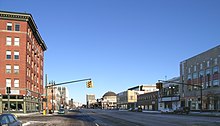
Detroit has a variety of neighborhood types. The revitalized Downtown,Midtown, Corktown,New Centerareas feature many historic buildings and are high density, while further out, particularly in the northeast and on the fringes,[133]high vacancy levels are problematic, for which a number of solutions have been proposed. In 2007,Downtown Detroitwas recognized as the best city neighborhood in which to retire among the United States' largest metro areas byCNNMoneyeditors.[134]
Lafayette Parkis arevitalizedneighborhood on the city'seast side, part of theLudwig Mies van der Roheresidential district.[135]The 78-acre (32 ha) development was originally called the Gratiot Park. Planned byMies van der Rohe,Ludwig HilberseimerandAlfred Caldwellit includes a landscaped, 19-acre (7.7 ha) park with no through traffic, in which these and other low-rise apartment buildings are situated.[135]Immigrants have contributed to the city's neighborhood revitalization, especially in southwest Detroit.[136]Southwest Detroit has experienced a thriving economy in recent years, as evidenced by new housing, increased business openings and the recently openedMexicantownInternational Welcome Center.[137]
The city has numerous neighborhoods consisting of vacant properties resulting in low inhabited density in those areas, stretching city services and infrastructure. These neighborhoods are concentrated in the northeast and on the city's fringes.[133]A 2009 parcel survey found about a quarter of residential lots in the city to be undeveloped or vacant, and about 10% of the city's housing to be unoccupied.[133][138][139]The survey also reported that most (86%) of the city's homes are in good condition with a minority (9%) in fair condition needing only minor repairs.[138][139][140][141]
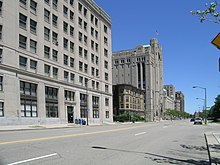

To deal with vacancy issues, the city has begun demolishing the derelict houses, razing 3,000 of the total 10,000 in 2010,[142]but the resulting low density creates a strain on the city's infrastructure. To remedy this, a number of solutions have been proposed including resident relocation from more sparsely populated neighborhoods and converting unused space to urban agricultural use, includingHantz Woodlands, though the city expects to be in the planning stages for up to another two years.[143][144]
Public funding and private investment have been made with promises to rehabilitate neighborhoods. In April 2008, the city announced a $300 million (~$417 million in 2023) stimulus plan to create jobs and revitalize neighborhoods, financed by city bonds and paid for by earmarking about 15% of the wagering tax.[143]The city's working plans for neighborhood revitalizations include 7-Mile/Livernois,Brightmoor, East English Village, Grand River/Greenfield,North End, andOsborn.[143]Private organizations have pledged substantial funding to the efforts.[145][146]Additionally, the city has cleared a 1,200-acre (490 ha) section of land for large-scale neighborhood construction, which the city is calling theFar Eastside Plan.[147]In 2011, MayorDave Bingannounced a plan to categorize neighborhoods by their needs and prioritize the most needed services for those neighborhoods.[148]
Parks
[edit]Detroit Parks & Recreation maintains 308 public parks, totaling 4,950 (2,003 ha) acres or about 5.6% of the city's land area.Belle Isle Park, Detroit's largest and most visited park is the largest city-owned island park in the U.S., covering 982 acres (397 ha).
Climate
[edit]| Detroit, Michigan | ||||||||||||||||||||||||||||||||||||||||||||||||||||||||||||
|---|---|---|---|---|---|---|---|---|---|---|---|---|---|---|---|---|---|---|---|---|---|---|---|---|---|---|---|---|---|---|---|---|---|---|---|---|---|---|---|---|---|---|---|---|---|---|---|---|---|---|---|---|---|---|---|---|---|---|---|---|
| Climate chart (explanation) | ||||||||||||||||||||||||||||||||||||||||||||||||||||||||||||
|
||||||||||||||||||||||||||||||||||||||||||||||||||||||||||||
|
||||||||||||||||||||||||||||||||||||||||||||||||||||||||||||
Detroit and the rest of southeastern Michigan have a hot-summerhumid continental climate(Köppen:Dfa) which is influenced by theGreat Lakeslike other places in thestate;[149][150][151]the city and close-in suburbs are part of USDAHardiness zone6b, while the more distant northern and western suburbs generally are included in zone 6a.[152]Winters are cold, with moderate snowfall and temperatures not rising above freezing on an average 44 days annually, while dropping to or below 0 °F (−18 °C) on an average 4.4 days a year; summers are warm to hot with temperatures exceeding 90 °F (32 °C) on 12 days.[153]The warm season runs from May to September. The monthly daily mean temperature ranges from 25.6 °F (−3.6 °C) in January to 73.6 °F (23.1 °C) in July. Official temperature extremes range from 105 °F (41 °C) on July 24, 1934, down to −21 °F (−29 °C) on January 21, 1984; the record low maximum is −4 °F (−20 °C) onJanuary 19, 1994, while, conversely the record high minimum is 80 °F (27 °C) on August 1, 2006, the most recent of five occurrences.[153]A decade or two may pass between readings of 100 °F (38 °C) or higher, which last occurredJuly 17, 2012. The average window for freezing temperatures is October 20 through April 22, allowing a growing season of 180 days.[153]
Precipitation is moderate and somewhat evenly distributed throughout the year, although the warmer months such as May and June average more, averaging 33.5 inches (850 mm) annually, but historically ranging from 20.49 in (520 mm) in 1963 to 47.70 in (1,212 mm) in 2011.[153]Snowfall, which typically falls in measurable amounts between November 15 through April 4 (occasionally in October and very rarely in May),[153]averages 42.5 inches (108 cm) per season, although historically ranging from 11.5 in (29 cm) in 1881–82 to 94.9 in (241 cm) in2013–14.[153]A thick snowpack is not often seen, with an average of only 27.5 days with 3 in (7.6 cm) or more of snow cover.[153]Thunderstormsare frequent in the Detroit area. These usually occur during spring and summer.[154]
| Climate data for Detroit (DTW), 1991–2020 normals,[a]extremes 1874–present[b] | |||||||||||||
|---|---|---|---|---|---|---|---|---|---|---|---|---|---|
| Month | Jan | Feb | Mar | Apr | May | Jun | Jul | Aug | Sep | Oct | Nov | Dec | Year |
| Record high °F (°C) | 67 (19) |
73 (23) |
86 (30) |
89 (32) |
95 (35) |
104 (40) |
105 (41) |
104 (40) |
100 (38) |
92 (33) |
81 (27) |
69 (21) |
105 (41) |
| Mean maximum °F (°C) | 53.0 (11.7) |
55.3 (12.9) |
69.3 (20.7) |
79.6 (26.4) |
87.2 (30.7) |
92.6 (33.7) |
93.8 (34.3) |
92.1 (33.4) |
89.3 (31.8) |
80.6 (27.0) |
66.7 (19.3) |
56.1 (13.4) |
95.4 (35.2) |
| Mean daily maximum °F (°C) | 32.3 (0.2) |
35.2 (1.8) |
45.9 (7.7) |
58.7 (14.8) |
70.3 (21.3) |
79.7 (26.5) |
83.7 (28.7) |
81.4 (27.4) |
74.4 (23.6) |
62.0 (16.7) |
48.6 (9.2) |
37.2 (2.9) |
59.1 (15.1) |
| Daily mean °F (°C) | 25.8 (−3.4) |
28.0 (−2.2) |
37.2 (2.9) |
48.9 (9.4) |
60.3 (15.7) |
69.9 (21.1) |
74.1 (23.4) |
72.3 (22.4) |
64.9 (18.3) |
53.0 (11.7) |
41.2 (5.1) |
31.3 (−0.4) |
50.6 (10.3) |
| Mean daily minimum °F (°C) | 19.2 (−7.1) |
20.8 (−6.2) |
28.6 (−1.9) |
39.1 (3.9) |
50.2 (10.1) |
60.2 (15.7) |
64.4 (18.0) |
63.2 (17.3) |
55.5 (13.1) |
44.0 (6.7) |
33.9 (1.1) |
25.3 (−3.7) |
42.0 (5.6) |
| Mean minimum °F (°C) | 0.1 (−17.7) |
3.5 (−15.8) |
12.0 (−11.1) |
25.5 (−3.6) |
36.3 (2.4) |
47.3 (8.5) |
54.1 (12.3) |
53.4 (11.9) |
41.6 (5.3) |
31.0 (−0.6) |
19.8 (−6.8) |
8.8 (−12.9) |
−3.7 (−19.8) |
| Record low °F (°C) | −21 (−29) |
−20 (−29) |
−4 (−20) |
8 (−13) |
25 (−4) |
36 (2) |
42 (6) |
38 (3) |
29 (−2) |
17 (−8) |
0 (−18) |
−11 (−24) |
−21 (−29) |
| Averageprecipitationinches (mm) | 2.23 (57) |
2.08 (53) |
2.43 (62) |
3.26 (83) |
3.72 (94) |
3.26 (83) |
3.51 (89) |
3.26 (83) |
3.22 (82) |
2.53 (64) |
2.57 (65) |
2.25 (57) |
34.32 (872) |
| Average snowfall inches (cm) | 14.0 (36) |
12.5 (32) |
6.2 (16) |
1.5 (3.8) |
0.0 (0.0) |
0.0 (0.0) |
0.0 (0.0) |
0.0 (0.0) |
0.0 (0.0) |
0.0 (0.0) |
1.9 (4.8) |
8.9 (23) |
45.0 (114) |
| Average extreme snow depth inches (cm) | 7.1 (18) |
6.6 (17) |
4.4 (11) |
0.8 (2.0) |
0.0 (0.0) |
0.0 (0.0) |
0.0 (0.0) |
0.0 (0.0) |
0.0 (0.0) |
0.0 (0.0) |
1.1 (2.8) |
4.3 (11) |
10.0 (25) |
| Average precipitation days(≥ 0.01 in) | 13.4 | 11.0 | 11.1 | 12.5 | 12.9 | 10.7 | 10.5 | 9.7 | 9.5 | 10.6 | 11.0 | 13.1 | 136.0 |
| Average snowy days(≥ 0.1 in) | 10.7 | 9.2 | 5.3 | 1.5 | 0.1 | 0.0 | 0.0 | 0.0 | 0.0 | 0.2 | 2.6 | 8.0 | 37.6 |
| Averagerelative humidity(%) | 74.7 | 72.5 | 70.0 | 66.0 | 65.3 | 67.3 | 68.5 | 71.5 | 73.4 | 71.6 | 74.6 | 76.7 | 71.0 |
| Averagedew point°F (°C) | 16.2 (−8.8) |
17.6 (−8.0) |
25.9 (−3.4) |
35.1 (1.7) |
45.7 (7.6) |
55.6 (13.1) |
60.4 (15.8) |
59.7 (15.4) |
53.2 (11.8) |
41.4 (5.2) |
32.4 (0.2) |
21.9 (−5.6) |
38.7 (3.7) |
| Mean monthlysunshine hours | 119.9 | 138.3 | 184.9 | 217.0 | 275.9 | 301.8 | 317.0 | 283.5 | 227.6 | 176.0 | 106.3 | 87.7 | 2,435.9 |
| Percentpossible sunshine | 41 | 47 | 50 | 54 | 61 | 66 | 69 | 66 | 61 | 51 | 36 | 31 | 55 |
| Averageultraviolet index | 1.2 | 2.0 | 3.6 | 5.4 | 6.9 | 8.0 | 8.2 | 7.1 | 5.3 | 3.1 | 1.6 | 1.1 | 4.4 |
| Source 1:NOAA(relative humidity, dew point, and sun 1961–1990)[153][155][156] | |||||||||||||
| Source 2: UV Index Today (1995 to 2022)[157] | |||||||||||||
|
|
Graphs are unavailable due to technical issues. There is more info on
Phabricatorand on
MediaWiki.org.
|
See or editraw graph data.
| Climate data for Detroit | |||||||||||||
|---|---|---|---|---|---|---|---|---|---|---|---|---|---|
| Month | Jan | Feb | Mar | Apr | May | Jun | Jul | Aug | Sep | Oct | Nov | Dec | Year |
| Mean No. of days with Maximum temperature => 90.0 °F (32.2 °C) | 0 | 0 | 0 | 0 | 1 | 3 | 5 | 3 | 1 | 0 | 0 | 0 | 13 |
| Mean No. of days with Minimum temperature => 68.0 °F (20.0 °C) | 0 | 0 | 0 | 0 | 1 | 5 | 10 | 8 | 2 | 0 | 0 | 0 | 25 |
| Mean No. of days with Minimum temperature <= 32.0 °F (0.0 °C) | 27 | 25 | 21 | 6 | 0 | 0 | 0 | 0 | 0 | 2 | 14 | 24 | 120 |
| Mean No. of days with Maximum temperature <= 32.0 °F (0.0 °C) | 16 | 12 | 3 | 0 | 0 | 0 | 0 | 0 | 0 | 0 | 1 | 10 | 42 |
| Mean No. of days with snow depth => 0.1 in (0.25 cm) | 17 | 14 | 6 | 1 | 0 | 0 | 0 | 0 | 0 | 0 | 2 | 8 | 48 |
| Average sea temperature °F (°C) | 33.6 (0.9) |
32.7 (0.4) |
33.4 (0.8) |
39.7 (4.3) |
48.9 (9.4) |
63.9 (17.7) |
74.7 (23.7) |
75.4 (24.1) |
70.5 (21.4) |
60.3 (15.7) |
48.6 (9.2) |
38.1 (3.4) |
51.7 (10.9) |
| Mean daily daylight hours | 9.0 | 11.0 | 12.0 | 13.0 | 15.0 | 15.0 | 15.0 | 14.0 | 12.0 | 11.0 | 10.0 | 9.0 | 12.2 |
| AverageUltraviolet index | 1 | 2 | 4 | 6 | 7 | 8 | 9 | 8 | 6 | 4 | 2 | 1 | 4.8 |
| Source 1: NWS (1991–2020)[158] | |||||||||||||
| Source 2 : Weather Atlas (daylight-UV-water temperature)[159] | |||||||||||||
Demographics
[edit]
| Census | Pop. | Note | %± |
|---|---|---|---|
| 1820 | 1,422 | — | |
| 1830 | 2,222 | 56.3% | |
| 1840 | 9,102 | 309.6% | |
| 1850 | 21,019 | 130.9% | |
| 1860 | 45,619 | 117.0% | |
| 1870 | 79,577 | 74.4% | |
| 1880 | 116,340 | 46.2% | |
| 1890 | 205,876 | 77.0% | |
| 1900 | 285,704 | 38.8% | |
| 1910 | 465,766 | 63.0% | |
| 1920 | 993,678 | 113.3% | |
| 1930 | 1,568,662 | 57.9% | |
| 1940 | 1,623,452 | 3.5% | |
| 1950 | 1,849,568 | 13.9% | |
| 1960 | 1,670,144 | −9.7% | |
| 1970 | 1,514,063 | −9.3% | |
| 1980 | 1,203,368 | −20.5% | |
| 1990 | 1,027,974 | −14.6% | |
| 2000 | 951,270 | −7.5% | |
| 2010 | 713,777 | −25.0% | |
| 2020 | 639,111 | −10.5% | |
| 2023 (est.) | 633,218 | [4] | −0.9% |
| U.S. Decennial Census[160] 2010–2020[9] |
|||
In the2020 United States Census, the city had 639,111 residents, ranking it the27th most populous cityin the United States.[161][162]Of the largeshrinking citiesin the United States, Detroit has had the most dramatic decline in the population of the past 70 years (down 1,210,457) and the second-largest percentage decline (down 65.4%). While the drop in Detroit's population has been ongoing since 1950, the most dramatic period was the significant 25% decline between the2000and 2010 Census.[162]

Detroit's 639,111 residents represent 269,445 households, and 162,924 families residing in the city. The population density was 5,144.3 people per square mile (1,986.2 people/km2). There were 349,170 housing units at an average density of 2,516.5 units per square mile (971.6 units/km2). Of the 269,445 households, 34.4% had children under the age of 18 living with them, 21.5% were married couples living together, 31.4% had a female householder with no husband present, 39.5% were non-families, 34.0% were made up of individuals, and 3.9% had someone living alone who was 65 years of age or older. The average household size was 2.59, and the average family size was 3.36.
There was a wide distribution of age in the city, with 31.1% under the age of 18, 9.7% from 18 to 24, 29.5% from 25 to 44, 19.3% from 45 to 64, and 10.4% 65 years of age or older. The median age was 31 years. For every 100 females, there were 89.1 males. For every 100 females age 18 and over, there were 83.5 males.
Religion
[edit]According to a 2014 study, 67% of the population of the city identified themselves asChristians, with 49% professing attendance atProtestantchurches, and 16% professingRoman Catholicbeliefs,[163][164]while 24% claimno religious affiliation. Other religions collectively make up about 8% of the population.
Income and employment
[edit]The loss of industrial and working-class jobs in the city has resulted in high rates of poverty and associated problems.[165]From 2000 to 2009, the city's estimated median household income fell from $29,526 to $26,098.[166]As of 2010[update], the mean income of Detroit is below the overall U.S. average by several thousand dollars. Of every three Detroit residents, one lives in poverty. Luke Bergmann, author ofGetting Ghost: Two Young Lives and the Struggle for the Soul of an American City, said in 2010, "Detroit is now one of the poorest big cities in the country".[167]
In the 2018American Community Survey, median household income in the city was $31,283, compared with the median for Michigan of $56,697.[168]The median income for a family was $36,842, well below the state median of $72,036.[169]33.4% of families had income at or below the federally defined poverty level. Out of the total population, 47.3% of those under the age of 18 and 21.0% of those 65 and older had income at or below the federally defined poverty line.[170]
| Area | Number of house- holds |
Median House- hold Income |
Per Capita Income |
Percent- age in poverty |
|---|---|---|---|---|
| Detroit City | 263,688 | $30,894 ( |
$18,621 ( |
35.0% ( |
| Wayne County, MI | 682,282 | $47,301 | $27,282 | 19.8% |
| United States | 120,756,048 | $62,843 | $34,103 | 11.4% |
Race and ethnicity
[edit]| Historical Racial Composition | 2020[172] | 2010[173] | 1990[55] | 1970[55] | 1950[55] | 1940[55] | 1930[55] | 1920[55] | 1910[55] |
|---|---|---|---|---|---|---|---|---|---|
| White | 14.7% | 10.6% | 21.6% | 55.5% | 83.6% | 90.7% | 92.2% | 95.8% | 98.7% |
| —Non-Hispanic | 11% | 7.8% | 20.7% | 54.0%[c] | — | 90.4% | — | — | — |
| Black or African American | 77.7% | 82.7% | 75.7% | 43.7% | 16.2% | 9.2% | 7.7% | 4.1% | 1.2% |
| Hispanic or Latino(of any race) | 8.0% | 6.8% | 2.8% | 1.8%[c] | — | 0.3% | — | — | — |
| Asian | 1.6% | 1.1% | 0.8% | 0.3% | 0.1% | 0.1% | 0.1% | 0.1% | — |
| Race / Ethnicity(NH = Non-Hispanic) | Pop 2000[174] | Pop 2010[175] | Pop 2020[176] | % 2000 | % 2010 | % 2020 |
|---|---|---|---|---|---|---|
| Whitealone (NH) | 99,921 | 55,604 | 60,770 | 10.50% | 7.79% | 10.10% |
| Black or African Americanalone (NH) | 771,966 | 586,573 | 493,212 | 81.15% | 82.18% | 77.17% |
| Native AmericanorAlaska Nativealone (NH) | 2,572 | 1,927 | 1,399 | 0.27% | 0.27% | 0.22% |
| Asianalone (NH) | 9,135 | 7,436 | 10,085 | 0.96% | 1.04% | 1.58% |
| Pacific Islanderalone (NH) | 169 | 82 | 111 | 0.02% | 0.01% | 0.02% |
| Some Other Racealone (NH) | 1,676 | 994 | 3,066 | 0.18% | 0.14% | 0.48% |
| Mixed Race or Multi-Racial(NH) | 18,664 | 12,482 | 19,199 | 1.96% | 1.75% | 3.00% |
| Hispanic or Latino(any race) | 47,167 | 48,679 | 51,269 | 4.96% | 6.82% | 8.02% |
| Total | 951,270 | 713,777 | 639,111 | 100.00% | 100.00% | 100.00% |

Beginning with the rise of the automobile industry, Detroit's population increased more than sixfold during the first half of the 20th century as an influx of European, Middle Eastern (Lebanese,Assyrian/Chaldean), and Southern migrants brought their families to the city.[177]With this economic boom following World War I, the African American population grew from a mere 6,000 in 1910[178]to more than 120,000 by 1930.[179]Perhaps one of the most overt examples of neighborhood discrimination occurred in 1925 when African American physicianOssian Sweetfound his home surrounded by an angry mob of his hostile white neighbors violently protesting his new move into a traditionally white neighborhood. Sweet and ten of his family members and friends were put on trial for murder as one of the mob members throwing rocks at the newly purchased house was shot and killed by someone firing out of a second-floor window.[180]
Detroit has a relatively large Mexican-American population. In the early 20th century, thousands of Mexicans came to Detroit to work in agricultural, automotive, and steel jobs. During theMexican Repatriationof the 1930s many Mexicans in Detroit were willingly repatriated or forced to repatriate. By the 1940s much of the Mexican community began to settle what is nowMexicantown.[181]Immigration fromJaliscosignificantly increased the Latino population in the 1990s. By 2010 Detroit had 48,679 Hispanics, including 36,452 Mexicans: a 70% increase from 1990.[182]

After World War II, many people fromAppalachiaalso settled in Detroit. Appalachians formed communities and their children acquired southern accents.[183]Many Lithuanians also settled in Detroit during the World War II era, especially on the city's Southwest side in theWest Vernorarea,[184]where the renovated Lithuanian Hall reopened in 2006.[185][186]
While African Americans previously[when?]comprised only 13% of Michigan's population, by 2010 they made up nearly 82% of Detroit's population. The next largest population groups were white people, at 10%, and Hispanics, at 6%.[187]In 2001, 103,000 Jews, or about 1.9% of the population, were living in the Detroit area.[188]According to the 2010 census, segregation in Detroit has decreased in absolute and relative terms and in the first decade of the 21st century, about two-thirds of the total black population in the metropolitan area resided within the city limits of Detroit.[189][190]The number of integrated neighborhoods increased from 100 in 2000 to 204 in 2010. Detroit also moved down the ranking from number one most segregated city to number four.[191]A 2011 op-ed inThe New York Timesattributed the decreased segregation rating to the overall exodus from the city, cautioning that these areas may soon become more segregated.

As of 2002, Detroit's percentage of Asians was 1%.[192]There are four areas in Detroit with significant Asian and Asian American populations. Northeast Detroit has a large population ofHmong[193]with a smaller group ofLaopeople. A portion of Detroit next to easternHamtramckincludesBangladeshi Americans,Indian Americans, andPakistani Americans; nearly all of the Bangladeshi population in Detroit lives in that area. The area north of downtown has transient Asian national origin residents who are university students or hospital workers. Few of them have permanent residency after schooling ends. They are mostly Chinese and Indian but the population also includes Filipinos, Koreans, and Pakistanis. In Southwest Detroit and western Detroit there are smaller, scattered Asian communities.[192][194]
Economy
[edit]| Top city employers as of 2014 Source:Crain's Detroit Business[195] |
||
| Rank | Company or organization | # |
|---|---|---|
| 1 | Detroit Medical Center | 11,497 |
| 2 | City of Detroit | 9,591 |
| 3 | Rocket Mortgage | 9,192 |
| 4 | Henry Ford Health System | 8,807 |
| 5 | Detroit Public Schools | 6,586 |
| 6 | U.S. Government | 6,308 |
| 7 | Wayne State University | 6,023 |
| 8 | Chrysler | 5,426 |
| 9 | Blue Cross Blue Shield | 5,415 |
| 10 | General Motors | 4,327 |
| 11 | State of Michigan | 3,911 |
| 12 | DTE Energy | 3,700 |
| 13 | St. John Providence Health System | 3,566 |
| 14 | U.S. Postal Service | 2,643 |
| 15 | Wayne County | 2,566 |
| 16 | MGM Grand Detroit | 2,551 |
| 17 | MotorCity Casino | 1,973 |
| 18 | Compuware | 1,912 |
| 19 | Detroit Diesel | 1,685 |
| 20 | Greektown Casino | 1,521 |
| 21 | Comerica | 1,194 |
| 22 | Deloitte | 942 |
| 23 | Johnson Controls | 760 |
| 24 | PwC | 756 |
| 25 | Ally Financial | 715 |
Several major corporations are based in the city, including three Fortune 500 companies. The most heavily represented sectors are manufacturing (particularly automotive), finance, technology, and health care. The most significant companies based in Detroit includeGeneral Motors,Rocket Mortgage,Ally Financial,Compuware,Shinola,American Axle,Little Caesars,DTE Energy,Lowe Campbell Ewald,Blue Cross Blue Shield of Michigan, andRossetti Architects.
About 80,500 people work in downtown Detroit, comprising one-fifth of the city's employment base.[196][197]Aside from the numerous Detroit-based companies listed above, downtown contains large offices forComerica,Chrysler,Fifth Third Bank,HP Enterprise,Deloitte,PricewaterhouseCoopers,KPMG, andErnst & Young.Ford Motor Companyis in the adjacent city ofDearborn.[198]
Thousands more employees work in Midtown, north of the central business district. Midtown's anchors are the city's largest single employerDetroit Medical Center,Wayne State University, and theHenry Ford Health Systemin New Center. Midtown is also home to watchmakerShinolaand an array of small andstartupcompanies.New CenterbasesTechTown, a research and business incubator hub that is part of the Wayne State University system.[199]Like downtown,CorktownIs experiencing growth with the new Ford Corktown Campus under development.[200][201]

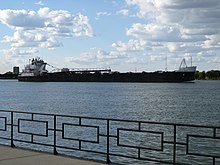
Many downtown employers are relatively new, as there has been a marked trend of companies moving from satellite suburbs into the downtown core.[202]Compuware completed itsworld headquartersin downtown in 2003.OnStar,Blue Cross Blue Shield, andHP Enterprise Servicesare at the Renaissance Center.PricewaterhouseCoopersPlaza offices are adjacent toFord Field, andErnst & Youngcompleted its office building atOne Kennedy Squarein 2006. Perhaps most prominently, in 2010, Quicken Loans, one of the largest mortgage lenders, relocated its world headquarters and 4,000 employees to downtown Detroit, consolidating its suburban offices.[203]In July 2012, the U.S. Patent and Trademark Office opened its Elijah J. McCoy Satellite Office in the Rivertown/Warehouse District as its first location outsideWashington, D.C.'s metropolitan area.[204]
In April 2014, theUnited States Department of Laborreported the city's unemployment rate at 14.5%.[205]

The city of Detroit and otherpublic–private partnershipshave attempted to catalyze the region's growth by facilitating the building and historical rehabilitation of residential high-rises in the downtown, creating a zone that offers many business tax incentives, creating recreational spaces such as the Detroit RiverWalk,Campus Martius Park,Dequindre CutGreenway, and Green Alleys in Midtown. The city has cleared sections of land while retaining some historically significant vacant buildings in order to spur redevelopment;[206]even though it has struggled with finances, the city issued bonds in 2008 to provide funding for ongoing work to demolish blighted properties.[143]Two years earlier, downtown reported $1.3 billion in restorations and new developments which increased the number of construction jobs in the city.[80]In the decade prior to 2006, downtown gained more than $15 billion in new investment from private and public sectors.[207]
Despite the city's recent financial issues, many developers remain unfazed by Detroit's problems.[208]Midtown is one of the most successful areas within Detroit to have a residential occupancy rate of 96%.[209]Numerous developments have been recently completed or are in various stages of construction. These include the $82 million reconstruction of downtown'sDavid Whitney Building(now anAloft Hoteland luxury residences), the Woodward Garden Block Development in Midtown, the residential conversion of theDavid Broderick Towerin downtown, the rehabilitation of theBook Cadillac Hotel(now a Westin and luxury condos) andFort Shelby Hotel(now Doubletree) also in downtown, and various smaller projects.[210][80]
Downtown's population of young professionals is growing, and retail is expanding.[211][212]A study in 2007 found out that Downtown's new residents are predominantly young professionals (57% are ages 25 to 34, 45% have bachelor's degrees, and 34% have a master's or professional degree),[196][211][213]a trend which has hastened over the last decade. Since 2006, $9 billion has been invested in downtown and surrounding neighborhoods; $5.2 billion of which has come in 2013 and 2014.[214]Construction activity, particularly rehabilitation of historic downtown buildings, has increased markedly. As of 2014, the number of vacant downtown buildings has dropped from nearly 50 to around 13.[215]
In 2013Meijer, a midwestern retail chain, opened its first supercenter store in Detroit;[216]this was a $20 million, 190,000-square-foot store in the northern portion of the city and it also is the centerpiece of a new $72 million shopping center named Gateway Marketplace.[217]In 2015 Meijer opened its second supercenter store in the city.[218]In 2019JPMorgan Chaseannounced plans to invest $50 million more in affordable housing, job training, and entrepreneurship by the end of 2022, growing its investment to $200 million.[219]
Arts and culture
[edit]
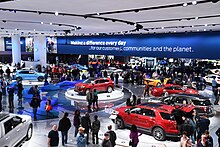
In the central portions of Detroit, the population of young professionals, artists, and other transplants is growing and retail is expanding.[211]This dynamic is luring additional new residents, and former residents returning from other cities, to the city's Downtown along with the revitalized Midtown and New Center areas.[196][211][213]
A desire to be closer to the urban scene has attracted some young professionals to reside in inner ring suburbs such asFerndaleandRoyal Oak.[220]The proximity to Windsor provides for views and nightlife, along with Ontario's minimum drinking age of 19.[221]A 2011 study byWalk Scorerecognized Detroit for its above average walkability among large U.S. cities.[222]About two-thirds of suburban residents occasionally dine and attend cultural events or take in professional games in the city.[223]
Nicknames
[edit]Known as the world's automotive center,[224]"Detroit" is ametonymforthat industry.[225]It is an important source of popular music legacies celebrated by the city's two familiar nicknames, theMotor CityandMotown.[226]Other nicknames arose in the 20th century, includingCity of Champions, beginning in the 1930s for its successes in individual and team sport;[227]The D;Hockeytown(a trademark owned by theDetroit Red Wings);Rock City(after theKisssong "Detroit Rock City"); andThe313(its telephone area code).[d][228]
Music
[edit]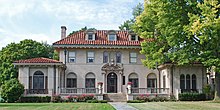
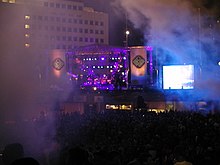
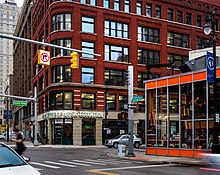
Live music has been a prominent feature of Detroit's nightlife since the late 1940s, bringing the city recognition under the nickname "Motown".[229]The metropolitan area has many nationally prominent live music venues. Concerts hosted byLive Nationperform throughout the Detroit area. The theater venue circuit is the United States' second largest and hostsBroadway performances.[230][231]
The city has a rich musical heritage and has contributed to many genres over the decades.[228]Important music events include theDetroit International Jazz Festival, theDetroit Electronic Music Festival, the Motor City Music Conference (MC2), the Urban Organic Music Conference, the Concert of Colors, and the hip-hop Summer Jamz festival.[228]
In the 1940s,Detroit bluesartistJohn Lee Hookerbecame a long-term resident in theDelrayneighborhood. Hooker, among other important blues musicians, migrated from his home in Mississippi, bringing theDelta bluesto Detroit. Hooker recorded forFortune Records, the biggest pre-Motown blues/soul label. During the 1950s, the city became a center for jazz, with stars performing in the Black Bottom neighborhood.[44]Prominent emerging jazz musicians included trumpeterDonald Byrd(who attended Cass Tech and performed withArt Blakeyandthe Jazz Messengersearly in his career) and saxophonistPepper Adams(who enjoyed a solo career and accompanied Byrd on several albums). The Graystone International Jazz Museum documents jazz in Detroit.[232]
Other prominent Motor City R&B stars in the 1950s and early 1960s wereNolan Strong,Andre Williams, andNathaniel Mayer—who all scored local and national hits on theFortune Recordslabel. According toSmokey Robinson, Strong was a primary influence on his voice as a teenager. The Fortune label, a family-operated label on Third Avenue, was owned by the husband-and-wife team of Jack Brown and Devora Brown. Fortune—which also released country, gospel and rockabilly LPs and 45s—laid the groundwork for Motown, which became Detroit's most legendary record label.[233]
Berry Gordy, Jr.foundedMotown Records, which rose to prominence during the 1960s and early 1970s with acts such asStevie Wonder,the Temptations,the Four Tops,Smokey Robinson & the Miracles,Diana Ross & the Supremes,the Jackson 5,Martha and the Vandellas,the Spinners,Gladys Knight & the Pips,the Marvelettes,the Elgins,the Monitors,the Velvelettes, andMarvin Gaye. Artists were backed by in-house vocalists[234]the Andantesandthe Funk Brothers.
"The Motown sound" played an important role in the crossover appeal with popular music, since it was the first African American–owned record label to primarily feature African-American artists. Gordy moved Motown to Los Angeles in 1972 to pursue film production, but the company has since returned to Detroit.Aretha Franklin, another Detroit R&B star, carried the Motown sound; however, she did not record with Berry's Motown label.[228]
Local artists and bands rose to prominence in the 1960s and 70s, including theMC5,Glenn Frey,the Stooges,Bob Seger,Amboy DukesfeaturingTed Nugent,Mitch Ryder, and The Detroit Wheels,Rare Earth,Alice Cooper, andSuzi Quatro. The groupKissemphasized the city's connection with rock in the song "Detroit Rock City" and the movie produced in 1999. In the 1980s, Detroit was an important center of thehardcore punk rockunderground with many nationally known bands coming out of the city and its suburbs, such asthe Necros,the Meatmen, andNegative Approach.[233]
In the 1990s and 2000s, the city produced many influentialhip hopartists, includingEminem, the hip-hop artist with the highest cumulative sales, his rap groupD12, hip-hop rapper and producerRoyce da 5'9", hip-hop producerDenaun Porter, hip-hop producerJ Dilla, rapper and musicianKid Rockand rappersBig SeanandDanny Brown. The bandSpongetoured and produced music.[228][233]The city also has an activegarage rockscene that has generated national attention with acts such asthe White Stripes,the Von Bondies,the Detroit Cobras,the Dirtbombs,Electric Six, andthe Hard Lessons.[228]Detroit is cited as the birthplace oftechnomusic in the early 1980s.[235]The city also lends its name to an early and pioneering genre ofelectronic dance music, "Detroit techno". Featuring science fiction imagery and robotic themes, its futuristic style was greatly influenced by the geography of Detroit's urban decline and its industrial past.[44]Prominent Detroit techno artists includeJuan Atkins,Derrick May,Kevin Saunderson, andJeff Mills. TheDetroit Electronic Music Festival, now known as Movement, occurs annually in late May on Memorial Day Weekend, and takes place inHart Plaza.
Performing arts
[edit]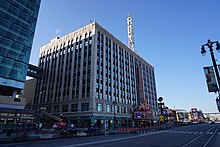
Major theaters in Detroit include theFox Theatre(5,174 seats),Music Hall Center for the Performing Arts(1,770 seats), theGem Theatre(451 seats),Masonic Temple Theatre(4,404 seats), theDetroit Opera House(2,765 seats), theFisher Theatre(2,089 seats),The Fillmore Detroit(2,200 seats),Saint Andrew's Hall, theMajestic Theater, andOrchestra Hall(2,286 seats), which hosts the renownedDetroit Symphony Orchestra. TheNederlander Organization, the largest controller of Broadway productions in New York City, originated with the purchase of theDetroit Opera Housein 1922 by the Nederlander family.[228]
Motown Motion Picture Studioswith 535,000 square feet (49,700 m2) produces movies in Detroit and the surrounding area based at the Pontiac Centerpoint Business Campus for a film industry expected to employ over 4,000 people in the metro area.[236]
Tourism
[edit]Detroit is home to the world's firstdestination marketing organization, the Detroit Metro Convention and Visitor's Bureau, also known as Visit Detroit.[237][238]Founded in 1896, the organization now operates at211 West Fort StreetasVisit Detroit.[239]

Because of its unique culture, distinctive architecture, and revitalization and urban renewal efforts in the 21st century, Detroit has enjoyed increased prominence as a tourist destination in recent years.The New York Timeslisted Detroit as the ninth-best destination in its list of52 Places to Go in 2017,[240]while travel guide publisherLonely Planetnamed Detroit the second-best city in the world to visit in 2018.[241]Timenamed Detroit as one of the 50 World's Greatest Places of 2022 to explore.[242]
Many of the area's prominent museums are in the historiccultural centerneighborhood around Wayne State University and theCollege for Creative Studies. These museums include theDetroit Institute of Arts, theDetroit Historical Museum,Charles H. Wright Museum of African American History, theDetroit Science Center, as well as the main branch of theDetroit Public Library. Other cultural highlights includeMotown Historical Museum, theFord Piquette Avenue Plantmuseum, thePewabic Potterystudio and school, theTuskegee AirmenMuseum,Fort Wayne, the Dossin Great Lakes Museum, theMuseum of Contemporary Art Detroit, theContemporary Art Institute of Detroit, and theBelle Isle Conservatory.
In 2010, the G.R. N'Namdi Gallery opened in a 16,000-square-foot (1,500 m2) complex in Midtown. Important history of America and the Detroit area are exhibited atThe Henry FordinDearborn, the United States' largest indoor-outdoor museum complex.[243]The Detroit Historical Society provides information about tours of area churches, skyscrapers, and mansions. Inside Detroit hosts tours, educational programming, and a downtown welcome center. Other sites of interest are theDetroit ZooinRoyal Oak, theCranbrook Art MuseuminBloomfield Hills, theAnna Scripps Whitcomb Conservatoryon Belle Isle, and Walter P. Chrysler Museum inAuburn Hills.[126]
Greektownand three downtown casino resort hotels serve as part of an entertainment hub. TheEastern Marketfarmer's distribution center is the largest open-air flowerbed market in the United States and has more than 150 foods and specialty businesses.[244]On Saturdays, about 45,000 people shop there.[245]The annual Detroit Festival of the Arts in Midtown draws about 350,000 people.[246]
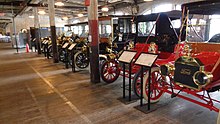
Annual summer events include theElectronic Music Festival,International Jazz Festival, theWoodward Dream Cruise, the African World Festival, the country music Hoedown, Noel Night, andDally in the Alley. Within downtown, Campus Martius Park hosts large events, including the annual Motown Winter Blast. As the world's traditional automotive center, the city hosts theNorth American International Auto Show. Held since 1924, America's Thanksgiving Parade is one of the nation's largest.[247]River Days, a five-day summer festival on the International Riverfront lead up to theWindsor–Detroit International Freedom Festivalfireworks, which draw super sized-crowds ranging from hundreds of thousands to over three million people.[223][228][248]
An important civic sculpture isThe Spirit of DetroitbyMarshall Fredericksat the Coleman Young Municipal Center. The image is often used as a symbol of Detroit, and the statue is occasionally dressed in sports jerseys to celebrate when a Detroit team is doing well.[249]Amemorial to Joe Louisis located at the intersection of Jefferson and Woodward Avenues. The sculpture, commissioned bySports Illustratedand executed byRobert Graham, is a 24-foot (7.3 m) long arm with a fisted hand suspended by a pyramidal framework.
Sports
[edit]Detroit is one of four U.S. cities that have venues within the city representing the four major sports in North America. Detroit is the only city to have its four major sports teams play within its downtown district.[250]Venues include:Comerica Park(home ofMLB'sDetroit Tigers),Ford Field(home of theNFL'sDetroit Lions), andLittle Caesars Arena(home of theNHL'sDetroit Red Wingsand theNBA'sDetroit Pistons).
Detroit has won titles in all four of the major professional sports leagues. The Tigers have won four World Series titles (1935,1945,1968, and1984). The Red Wings have won 11Stanley Cups(1935–36,1936–37,1942–43,1949–50,1951–52,1953–54,1954–55,1996–97,1997–98,2001–02,2007–08) (the most by an American NHL franchise).[251]The Lions have won 4 NFL titles (1935,1952,1953,1957). The Pistons have won three NBA titles (1989,1990,2004).[228]In the years following the mid-1930s, Detroit was referred to as the "City of Champions" after the Tigers, Lions, and Red Wings captured the three major professional sports championships in existence at the time in a seven-month period (the Tigers won the World Series in October 1935; the Lions won the NFL championship in December 1935; the Red Wings won the Stanley Cup in April 1936).[227]
Founded in 2012 as a semi-professional soccer club,Detroit City FCplays professional soccer in theUSL Championship. Nicknamed,Le Rouge, the club are two-time champions ofNISAsince joining in 2020. They play their home matches inKeyworth Stadium, which is located in the enclave ofHamtramck.[252]
In college sports, Detroit's central location within theMid-American Conference(MAC) has made it a frequent site for the league's championship events. While the MAC Basketball Tournament moved permanently toClevelandstarting in 2000, the MAC Football Championship Game has been played at Ford Field since 2004 and annually attracts 25,000 to 30,000 fans. The University of Detroit Mercy has anNCAA Division Iprogram, and Wayne State University has both NCAA Division I andIIprograms. The NCAA footballQuick Lane Bowlis held at Ford Field each December.
The city hosted the 2005MLB All-Star Game,Super Bowl XLin 2006, the2006and2012 World Series,WrestleMania 23in 2007, and theNCAAFinal Fourin April 2009. TheDetroit Indy Grand Prixis held in Belle Isle Park. In 2007, open-wheel racing returned to Belle Isle with bothIndy Racing LeagueandAmerican Le Mans SeriesRacing.[253]From 1982 to 1988, Detroit held theDetroit Grand Prix, at theDetroit street circuit.
In 1932, Eddie "The Midnight Express" Tolan from Detroit won the 100- and 200-meter races and two gold medals at the1932 Summer Olympics.Joe Louiswon the heavyweight championship of the world in 1937. Detroit has made the most bids to host the Summer Olympics without ever being awarded the games, with seven unsuccessful bids for the1944,1952,1956,1960,1964,1968, and1972summer games.[228]
In 2024, Detroit hosted theNFL Draft. Over 775,000 people were present in downtown Detroit over the course of the three-day event, making it the highest attended draft on record.[254]
Government
[edit]
The city is governed pursuant to thehome ruleCharter of the City of Detroit. The government is run by a mayor, the nine-memberDetroit City Council, the eleven-memberBoard of Police Commissioners, and a clerk. All of these officers are elected on a nonpartisan ballot, with the exception of four of the police commissioners, who are appointed by the mayor. Detroit has a "strong mayoral" system, with the mayor approving departmental appointments. The council approves budgets, but the mayor is not obligated to adhere to any earmarking. The city clerk supervises elections and is formally charged with the maintenance of municipal records. City ordinances and substantially large contracts must be approved by the council.[255][256]TheDetroit City Codeis thecodificationof Detroit'slocal ordinances.
Presently three Community Advisory Councils advise City Council representatives. Residents of each of Detroit's seven districts have the option of electing Community Advisory Councils.[257]The city clerk supervises elections and is formally charged with the maintenance of municipal records. Municipal elections for mayor, city council and city clerk are held at four-year intervals, in the year after presidential elections.[256]Following a November 2009 referendum, seven council members will be elected from districts beginning in 2013 while two will continue to be elected at-large.[258]
Detroit's courts are state-administered and elections are nonpartisan. The Probate Court for Wayne County is in theColeman A. Young Municipal Centerin downtown. The Circuit Court is across Gratiot Avenue in the Frank Murphy Hall of Justice. The city is home to the Thirty-Sixth District Court, as well as the First District of theMichigan Court of Appealsand theUnited States District Court for the Eastern District of Michigan. The city provides law enforcement through theDetroit Police Departmentand emergency services through theDetroit Fire Department.[259][260]
Politics
[edit]Beginning with its incorporation in 1802, Detroit has had a total of74 mayors. Detroit's last mayor from theRepublican PartywasLouis Miriani, who served from 1957 to 1962. In 1973, the city elected its first black mayor,Coleman Young. Despite development efforts, his combative style during his five terms in office was not well received by many suburban residents.[261]MayorDennis Archer, a former Michigan Supreme Court Justice, refocused the city's attention on redevelopment with a plan to permit three casinos downtown. By 2008, three major casino resort hotels established operations in the city.[262]
In 2000, the city requested an investigation by theUnited States Justice Departmentinto the Detroit Police Department which was concluded in 2003 over allegations regarding its use of force and civil rights violations. The city proceeded with a major reorganization of the Detroit Police Department.[263]In 2013, felony bribery charges were brought against seven building inspectors.[264]In 2016, further corruption charges were brought against 12 principals, a former school superintendent and supply vendor[265]for a $12 million (~$14.9 million in 2023) kickback scheme.[266][267]However, law professor Peter Henning argues Detroit's corruption is not unusual for a city its size, especially when compared with Chicago.[268]
Detroit is sometimes referred to as asanctuary citybecause it has "anti-profiling ordinances that generally prohibit local police from asking about the immigration status of people who are not suspected of any crime".[269]The city in recent years has been a stronghold for theDemocratic Party, with around 94% of votes in the city going toJoe Biden, the Democratic candidate in the2020 Presidential election.
Education
[edit]Colleges and universities
[edit]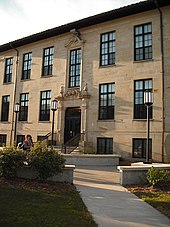
Detroit is home to several institutions of higher learning includingWayne State University, a national research university with medical andlaw schoolsin the Midtown area offering hundreds of academic degrees and programs. TheUniversity of Detroit Mercy, in northwest Detroit in theUniversity District, is a prominentRoman Catholicco-educationaluniversity affiliated with theSociety of Jesus(the Jesuits) and theSisters of Mercy. TheUniversity of Detroit Mercy School of Lawis downtown across from the Renaissance Center.[270]
Grand Valley State University's Detroit Center hosts workshops, seminars, professional development, and other large gatherings. Located in the heart of downtown next to Comerica Park and the Detroit Athletic Club, the center has become a key component for educational activity in the city.[271]
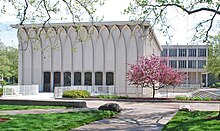
Sacred Heart Major Seminary, founded in 1919, is affiliated withPontifical University of Saint Thomas Aquinas,Angelicumin Rome and offers pontifical degrees as well as civil undergraduate and graduate degrees. Other institutions in the city include theCollege for Creative StudiesandWayne County Community College. In June 2009, theMichigan State University College of Osteopathic Medicinewhich is based inEast Lansingopened a satellite campus at theDetroit Medical Center.
Primary and secondary schools
[edit]As of 2016[update]many K-12 students in Detroit frequently change schools, with some children having been enrolled in seven schools before finishing their K-12 careers. There is a concentration of senior high schools andcharter schoolsin the downtown area, which had wealthier residents and more gentrification relative to other parts of Detroit: Downtown, northwest Detroit, and northeast Detroit have 1,894, 3,742, and 6,018 students of high school age, respectively, while they have 11, three, and two high schools, respectively.[272]As of 2016[update]because of the lack of public transportation and the lack of school bus services, many Detroit families have to rely on themselves to transport children to school.[272]
Public schools and charter schools
[edit]

With about 66,000 public school students (2011–12), theDetroit Public Schools(DPS) district is the largestschool districtin Michigan. Detroit has an additional 56,000 charter school students for a combined enrollment of about 122,000 students.[273][274]As of 2009[update]there are about as many students in charter schools as there are in district schools.[275]As of 2016[update]DPS continues to have the majority of the special education pupils. In addition, some Detroit students, as of 2016, attend public schools in other municipalities.[272]
In 1999, theMichigan Legislatureremoved the locally elected board of education amid allegations of mismanagement and replaced it with a reform board appointed by the mayor and governor. The elected board of education was re-established following a city referendum in 2005. The first election of the new 11-member board of education occurred on November 8, 2005.[276]
With growing charter schools enrollment as well as a continued exodus of population, the city planned to close many public schools.[273]State officials report a 68% graduation rate for Detroit's public schools adjusted for those who change schools.[277][278]Traditional public and charter school students in the city have performed poorly on standardized tests.c. 2009and 2011, while Detroit traditional public schools scored a record low on national tests, the publicly funded charter schools did even worse than the traditional public schools.[279][280]As of 2016[update]there were 30,000 excess openings in Detroit traditional public and charter schools, bearing in mind the number of K-12-aged children in the city. In 2016,Kate ZernikeofThe New York Timesstated school performance did not improve despite the proliferation of charters, describing the situation as "lots of choice, with no good choice".[272]
Detroit public schools students scored the lowest on tests of reading and writing of all major cities in the United States in 2015. Among eighth-graders, only 27% showed basic proficiency in math and 44% in reading.[281]Nearly half of Detroit's adults arefunctionally illiterate.[282]
Private schools
[edit]Detroit is served by various private schools, as well as parochial Roman Catholic schools operated by theArchdiocese of Detroit. As of 2013[update]there are four Catholic grade schools and three Catholic high schools in the City of Detroit, with all of them in the city's west side.[283]The Archdiocese of Detroit lists a number of primary and secondary schools in the metro area as Catholic education has emigrated to the suburbs.[284][285]Of the three Catholic high schools, two are operated by the Society of Jesus and the third is co-sponsored by theSisters, Servants of the Immaculate Heart of Maryand theCongregation of St. Basil.[286][287]
Media
[edit]
TheDetroit Free PressandThe Detroit Newsare the major daily newspapers, bothbroadsheetpublications published together under ajoint operating agreementcalled theDetroit Media Partnership. Media philanthropy includes theDetroit Free Presshigh school journalism program and the Old Newsboys' Goodfellow Fund of Detroit.[288]In March 2009, the two newspapers reduced home delivery to three days per week, print reduced newsstand issues of the papers on non-delivery days and focus resources on Internet-based news delivery.[289]TheMetro Times, founded in 1980, is a weekly publication, covering news, arts & entertainment.[290]
Founded in 1935 and based in Detroit, theMichigan Chronicleis one of the oldest and most respected African-American weekly newspapers in America, covering politics, entertainment, sports and community events.[291]The Detroit television market is the 11th largest in the United States;[292]according to estimates that do not include audiences in large areas of Ontario (Windsor and its surrounding area on broadcast and cable TV, as well as several other cable markets in Ontario, such asOttawa) which receive and watch Detroit television stations.[292]
Detroit has the 11th largestradio marketin the United States,[293]though this ranking does not take into account Canadian audiences.[293]Nearby Canadian stations such as Windsor'sCKLW(whose jingles formerly proclaimed "CKLW-the Motor City") are popular in Detroit.[294]
Crime
[edit]| Detroit | |
|---|---|
| Crime rates* (2019) | |
| Violent crimes | |
| Homicide | 41.4 |
| Rape | 143.4 |
| Robbery | 353.3 |
| Aggravated assault | 1,425.8 |
| Total violent crime | 1,965.3 |
| Property crimes | |
| Burglary | 1,027.1 |
| Larceny-theft | 2,235.5 |
| Motor vehicle theft | 1,037.0 |
| Total property crime | 4,299.7 |
|
Notes
*Number of reported crimes per 100,000 population.
Source:FBI 2019 UCR data |
|
Detroit has gained notoriety for its high amount of crime, having struggled with it for decades. The number of homicides in 1974 was 714.[295][296]The homicide rate in 2022 was the third highest in the nation at 50.0 per 100,000.[297]Downtown typically has lower crime than national and state averages.[298]According to a 2007 analysis, Detroit officials note about 65 to 70 percent of homicides in the city were drug related,[299]with the rate of unsolved murders roughly 70%.[165]
Although the rate of violent crime dropped 11% in 2008,[300]violent crime in Detroit has not declined as much as the national average from 2007 to 2011.[301]The violent crime rate is one of the highest in the United States. Neighborhoodscout.com reported a crime rate of 62.18 per 1,000 residents for property crimes, and 16.73 per 1,000 for violent crimes (compared to national figures of 32 per 1,000 for property crimes and 5 per 1,000 for violent crime in 2008).[302]In 2012, crime in the city was among the reasons for more expensive car insurance.[303]
Areas of the city adjacent to the Detroit River are also patrolled by theUnited States Border Patrol.[304]
Infrastructure
[edit]
Health systems
[edit]There are over a dozen major hospitals, which include theDetroit Medical Center(DMC),Henry Ford Health System,St. John Health System, and the John D. Dingell VA Medical Center. DMC, a regionalLevel I trauma center, consists of Detroit Receiving Hospital and University Health Center,Children's Hospital of Michigan,Harper University Hospital,Hutzel Women's Hospital, Kresge Eye Institute,Rehabilitation Institute of Michigan,Sinai-Grace Hospital, and theKarmanos Cancer Institute. DMC has more than 2,000 licensed beds and 3,000 affiliated physicians. It is the largest private employer in the city.[305]The center is staffed by physicians from theWayne State University School of Medicine, the largest single-campus medical school in the United States and the fourth largest medical school overall.[305]
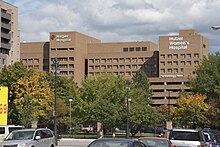
DMC formally became a part ofVanguard Health Systemson December 30, 2010, as a for-profit corporation. Vanguard has agreed to invest nearly $1.5 B in the DMC complex.[306][307]Vanguard has agreed to assume all debts and pension obligations.[306]The metro area has many other hospitals includingWilliam Beaumont Hospital, St. Joseph's, andUniversity of Michigan Medical Center.
In 2011, DMC and Henry Ford Health System substantially increased investments in medical research facilities and hospitals in the city's Midtown and New Center.[306][308]In 2012, two major construction projects were begun in New Center. The Henry Ford Health System started the first phase of a $500 million, 300-acre revitalization project, with the construction of a new $30 million, 275,000-square-foot,Medical Distribution CenterforCardinal Health, Inc.[309][310]and Wayne State University started construction on a new $93 million, 207,000-square-foot, Integrative Biosciences Center (IBio).[311][312]As many as 500 researchers and staff will work out of the IBio Center.[313]
Transportation
[edit]
With its proximity to Canada and its facilities, ports, major highways, rail connections and international airports, Detroit is an important transportation hub. The city has three international border crossings, theAmbassador Bridge,Detroit–Windsor TunnelandMichigan Central Railway Tunnel, linking Detroit to Windsor. The Ambassador Bridge is the single busiest border crossing in North America, carrying 27% of the total trade between the U.S. and Canada.[314]
In 2015 Canadian Transport Minister Lisa Raitt announced Canada agreed to pay the entire cost to build a $250 million U.S. Customs plaza adjacent to the planned new Detroit–Windsor bridge, now theGordie Howe International Bridge. Canada had already planned to pay for 95% of the bridge, which will cost $2.1 billion and is expected to open in 2024.[315]"This allows Canada and Michigan to move the project forward immediately to its next steps which include further design work and property acquisition on the U.S. side of the border", Raitt said in a statement issued after she spoke in the House of Commons.[316]
Transit systems
[edit]
Mass transit in the region is provided by bus services. TheDetroit Department of Transportationprovides service within city limits up to the outer edges of the city. From there, theSuburban Mobility Authority for Regional Transportation (SMART)provides service to the suburbs and the city regionally with local routes and SMART's FAST service. FAST is a new service provided by SMART which offers limited stops along major corridors throughout the Detroit metropolitan area connecting the suburbs to downtown. The new high-frequency service travels along three of Detroit's busiest corridors, Gratiot, Woodward, and Michigan, and only stops at designated FAST stops. Cross border service between the downtown areas of Windsor and Detroit is provided byTransit Windsorvia the Tunnel Bus.[317]
An elevated rail system known as thePeople Mover, completed in 1987, provides daily service around a 2.94-mile (4.73 km) loop downtown. TheQLINEserves as a link between the People Mover and theAmtrak stationvia Woodward Avenue.[318]TheAnn Arbor–Detroit Regional Railline will extend from New Center, connecting toAnn ArborviaDearborn,Wayne, andYpsilantiwhen it is opened.[319]
TheRegional Transit Authority (RTA)was established by an act of the Michigan legislature in 2012 to oversee and coordinate all existing regional mass transit operations, and to develop new transit services in the region. The RTA's first project was the introduction of RelfeX, alimited-stop, cross-county bus service connecting downtown and midtown Detroit with Oakland county via Woodward avenue.[320]
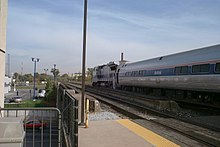
Amtrakprovides service to Detroit, operating itsWolverineservice between Chicago andPontiac. The Amtrak station is in New Center north of downtown. Intercity bus service is offered at theDetroit Bus Station.Greyhound Lines,Flixbus,Indian Trails, andBarons Bus Linesconnect Detroit with numerous cities across theMidwest.
Car ownership
[edit]The city of Detroit has a higher than average percentage of households without a car. In 2016, 24.7% of Detroit households lacked a car, much higher than the national average of 8.7%. Detroit averaged 1.15 cars per household in 2016, compared to a national average of 1.8.[321]
Freight railroads
[edit]Freight railroad operations in the city of Detroit are provided byCanadian National Railway,Canadian Pacific Railway,Conrail Shared Assets,CSX TransportationandNorfolk Southern Railway, each of which have local yards within the city. Detroit is also served by theDelray Connecting RailroadandDetroit Connecting Railroadshortlines.[322]
Airports
[edit]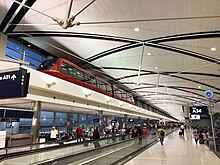
Detroit Metropolitan Wayne County Airport(DTW), the principal airport serving Detroit, is in nearbyRomulus. DTW is a primary hub forDelta Air Lines(following its acquisition of Northwest Airlines), and a secondary hub forSpirit Airlines. The airport is connected toDowntown Detroitby theSuburban Mobility Authority for Regional Transportation (SMART)FAST Michigan route.[323]
Coleman A. Young International Airport(DET), previously called Detroit City Airport, is on Detroit's northeast side; the airport now maintains only charter service andgeneral aviation.[324]Willow Run Airport, in western Wayne County near Ypsilanti, is a general aviation and cargo airport.[325]
Freeways
[edit]Metro Detroit has an extensive toll-free network of freeways administered by theMichigan Department of Transportation. Four major Interstate Highways surround the city. Detroit is connected viaI-75andI-96toKings Highway 401and to majorSouthern Ontariocities such asLondon, Ontarioand theGreater Toronto Area. I-75 (Chrysler and Fisher freeways) is the region's main north–south route, servingFlint,Pontiac,Troy, and Detroit, before continuing south (as the Detroit–Toledo and Seaway Freeways) to serve many of the communities along the shore of Lake Erie.[326]
I-94(Edsel Ford Freeway) runs east–west through Detroit and serves Ann Arbor to the west (where it continues toChicago) and Port Huron to the northeast. The stretch of the I-94 freeway from Ypsilanti to Detroit was one of America's earlier limited-access highways.Henry Fordbuilt it to link the factories at Willow Run and Dearborn during World War II. A portion was known as the Willow Run Expressway. The I-96 freeway runs northwest–southeast through Livingston, Oakland and Wayne counties and (as the Jeffries Freeway through Wayne County) has its eastern terminus in downtown Detroit.[326]
I-275runs north–south from I-75 in the south to the junction of I-96 andI-696in the north, providing a bypass through the western suburbs of Detroit.I-375is a short spur route in downtown Detroit, an extension of the Chrysler Freeway. I-696 (Reuther Freeway) runs east–west from the junction of I-96 and I-275, providing a route through the northern suburbs of Detroit. Taken together, I-275 and I-696 form a semicircle around Detroit. Michigan state highways designated with the letter M serve to connect major freeways.[326]
Floating post office
[edit]
Detroit has a floating post office, theJ. W. Westcott II, which serves lake freighters along the Detroit River. ItsZIP Codeis 48222.[327]The ZIP Code is used exclusively for theJ. W. Westcott II, which makes it the only floating ZIP Code in the United States. It has a land-based office at 12 24th Street, just south of the Ambassador Bridge. The J.W. Westcott Company was established in 1874 by CaptainJohn Ward Westcottas a maritime reporting agency to inform other vessels about port conditions,[328]and theJ. W. Westcott IIvessel began service in 1949 and is still in operation today.[329]
Notable people
[edit]Sister cities
[edit]Detroit'ssister citiesinclude the following:[330]
 Chongqing, China
Chongqing, China Dubai, United Arab Emirates
Dubai, United Arab Emirates Kitwe, Zambia
Kitwe, Zambia Minsk, Belarus
Minsk, Belarus Nassau, Bahamas
Nassau, Bahamas Toyota, Japan[331]
Toyota, Japan[331] Turin, Italy[332]
Turin, Italy[332]
See also
[edit]- USSDetroit, at least 6 ships
Notes
[edit]- ^Mean monthly maxima and minima (i.e. the highest and lowest temperature readings during an entire month or year) calculated based on data at said location from 1991 to 2020.
- ^Official records for Detroit were kept at downtown from January 1874 to December 1933,Detroit City Airportfrom February 1934 to March 1966, and at DTW since April 1966. For more information, seeThreadEx.
- ^abFrom 15% sample
- ^Commemorated in the movie8 Mile(2002)
References
[edit]- ^abc"Detroit".Geographic Names Information System.United States Geological Survey,United States Department of the Interior. RetrievedJuly 27,2009..
- ^"2020 U.S. Gazetteer Files". United States Census Bureau. RetrievedMay 21,2022.
- ^"City and Town Population Totals: 2020-2021". United States Census Bureau. May 30, 2022. RetrievedMay 30,2022.
- ^ab"City and Town Population Totals: 2020-2023". United States Census Bureau. May 16, 2024. RetrievedMay 16,2024.
- ^"List of 2020 Census Urban Areas".census.gov. United States Census Bureau. RetrievedJanuary 8,2023.
- ^"2020 Population and Housing State Data".Census.gov. United States Census Bureau. RetrievedAugust 22,2021.
- ^"Total Gross Domestic Product for Detroit-Warren-Dearborn, MI (MSA)".fred.stlouisfed.org.
- ^"Detroit – Definition and More from the Free Merriam-Webster Dictionary". Merriam-webster.com. April 25, 2007. RetrievedJuly 1,2010.
- ^abc"QuickFacts: Detroit city, Michigan". United States Census Bureau. RetrievedAugust 22,2021.
- ^"Michigan - Cultural life".Britannica. RetrievedJuly 9,2022.
- ^Clark, Anna (May 18, 2015)."An insider's cultural guide to Detroit: The Motor City moves on".The Guardian. RetrievedJuly 9,2022.
- ^abNolan, Jenny (June 15, 1999).How Prohibition made Detroit a bootlegger's dream townArchivedJuly 9, 2012, atarchive.today. Michigan History,The Detroit News. Retrieved on November 23, 2007.
- ^"Detroit bankruptcy officially over, finances handed back to the city".WXYZ. December 10, 2014. Archived fromthe originalon March 4, 2016.
- ^"Gross Domestic Product by County and Metropolitan Area | FRED | St. Louis Fed".fred.stlouisfed.org. RetrievedJuly 5,2024.
- ^Livengood, Chad (March 3, 2019)."Commentary: A MEGA bargain for Michigan's future".Crain's Detroit Business. Detroit.Archivedfrom the original on March 6, 2019. RetrievedFebruary 3,2020.
- ^Emmott, Robin (April 19, 2007)."Massive traffic cripples Tijuana border crossing".Reuters.
- ^"Travel USA Visitor Profile".Michigan Economic Development Corporation Box. Longwoods International. RetrievedJuly 20,2022.
- ^Hadley Keller (December 16, 2015)."Detroit Named First American City of Design by UNESCO".Architectural Digest.
- ^Rousseau, Mary (October 16, 2018)."How Did Michigan Cities Get Their Names?".Michigan. RetrievedFebruary 16,2022.
- ^"Detroit word origin".Etymologeek. RetrievedFebruary 16,2022.
- ^"La rivière du Détroit depuis le lac Érié, 1764". Archived fromthe originalon July 3, 2008. RetrievedMay 5,2009.
- ^List of U.S. place names of French origin
- ^Lemke, Ashley (2015). "Great Lakes Rangifer and Paleoindians: Archaeological and Paleontological Caribou Remains from Michigan".PaleoAmerica.1(3): 277.doi:10.1179/2055557115Y.0000000003.ISSN2055-5563.S2CID129841191.
- ^Teasdale, Guillaume (2012). "Old Friends and New Foes: French Settlers and Indians in the Detroit River Border Region".Michigan Historical Review.38(2): 35–62.doi:10.5342/michhistrevi.38.2.0035.
- ^DeVito, Lee."How New Red Order and MOCAD could redefine 'land acknowledgment' for Indigenous people".Detroit Metro Times. RetrievedJune 27,2021.
- ^abcdeWilliam Brandon (1961). Alvin M. Josephy, Jr. (ed.).The American Heritage Book of Indians. American Heritage Publishing Co., Inc. pp. 187–219.LCCN61-14871.
- ^"The French & Indian War, Seven Years War Summary".Totally History. September 9, 2011.
- ^"Museum Outreach".exhibitions.nysm.nysed.gov.
- ^Woodford, Arthur M. (2001).This is Detroit, 1701–2001. Wayne State University Press. pp.15.ISBN0814329144.
- ^Riley, John L. (2013).The Once and Future Great Lakes Country: An Ecological History. McGill-Queen's University Press.ISBN978-0-7735-4177-1., p. 56.
- ^Stechschulte, Michael (March 1, 2020)."Pope names Ste. Anne Church a basilica, cementing historic parish's importance to Detroit".Detroit Catholic. RetrievedNovember 13,2023.
- ^French Ontario in the 17th and 18th centuries – DetroitArchivedAugust 24, 2004, at theWayback Machine.Archives of OntarioJuly 14, 2008. Retrieved July 23, 2008.
- ^Jacqueline Peterson, Jennifer S. H. Brown,Many Roads to Red River(2001), p69
- ^LaForest, James (March 7, 2014)."'Muskrat French': French-Canadian River Culture in the Windsor/Detroit Region".Voyageur Heritage: Community Journal and Resource Guide. James LaForest. RetrievedSeptember 5,2015.
- ^Beneteau, Marcel."Detroit River: A Special Place in French North American History".Encyclopedia of French Cultural Heritage in North America. RetrievedSeptember 5,2015.
- ^Ross, Marc (January 18, 2017)."Why Detroit is Built to Succeed: Looking at Detroit's Past to See Its Future".Diplomatic Courier. Global Affairs Media. Archived fromthe originalon February 17, 2020. RetrievedFebruary 17,2020.
- ^""History of Detroit: A Chronicle of Its Progress" Page 71, 1912".Mocavo.com. RetrievedJune 29,2014.
- ^"Ste. Anne of Detroit"ArchivedSeptember 27, 2011, at theWayback Machine, St. Anne Church. Retrieved on April 29, 2006.
- ^"Great Fire of 1805 | Detroit Historical Society".detroithistorical.org.
- ^"RICHARD, FATHER GABRIEL".Detroit Historical Society. RetrievedJune 16,2024.
- ^"FLAG OF DETROIT".Detroit Historical Society. RetrievedJune 16,2024.
- ^"Flag of Detroit | Detroit Historical Society".detroithistorical.org. RetrievedJune 16,2024.
- ^"River Raisin National Battlefield Park".Nps.gov.
- ^abcdefghWoodford, Arthur M. (2001).This is Detroit 1701–2001. Wayne State University Press.ISBN0-8143-2914-4.
- ^Jackman, Michael (June 1, 2018)."How the Woodward Plan for greater Detroit died 200 years ago today".Detroit Metro Times. Archived fromthe originalon November 12, 2020.
- ^Chadwick, Bruce (1999).Traveling the underground railroad : a visitor's guide to more than 300 sites. Secaucus, NJ: Carol Pub. Group. p.272.ISBN0806520930.
- ^US Department of Interior, National Park Service, Denver Service Center (1995).Underground Railroad. DIANE Publishing. p. 168.
{{cite book}}: CS1 maint: multiple names: authors list (link) - ^Tobin, Jacqueline L.From Midnight to Dawn: The Last Tracks of the Underground Railroad. Anchor, 2008. p200-209
- ^Rosentreter, Roger (July/August 1998). "Come on you Wolverines, Michigan at Gettysburg",Michigan History.
- ^"Why do Hamtramck and Highland Park exist inside the city of Detroit?".Wdet.org. September 19, 2014. RetrievedJanuary 14,2021.
- ^"Biggest US Cities in 1920 - Historical Population Data".www.biggestuscities.com. RetrievedJune 4,2021.
- ^"Important U.S. Labor Leaders: Jimmy Hoffa".Cross Currents. CULCON (A Digital Cultural Resource of the US-Japan Conference on Cultural and Educational Interchange). 2003. RetrievedOctober 19,2017.
- ^"Detroit Race Riots 1943"ArchivedMarch 1, 2017, at theWayback Machine.Eleanor Roosevelt, WGBH, American Experience, PBS (June 20, 1983). Retrieved on September 5, 2013.
- ^Bak, Richard (February 23, 2009)."The Dark Days of the Black Legion".Hour Detroit. RetrievedJanuary 14,2021.
- ^abcdefgh"Race and Hispanic Origin for Selected Cities and Other Places: Earliest Census to 1990". U.S. Census Bureau. Archived fromthe originalon August 12, 2012.
- ^Sugrue, Thomas J. (March 26, 2011)."A Dream Still Deferred".The New York Times. Archived fromthe originalon January 1, 2022. RetrievedJuly 27,2012.
- ^Reynolds Farley; Sheldon Danziger; Harry J. Holzer (2002)."The Evolution of Racial Segregation".Detroit divided. New York: Russell Sage Foundation.ISBN978-0-87154-281-6.
- ^Route Listings: M-8. Michigan Highways. Retrieved on July 16, 2013.
- ^Nolan, Jenny (January 28, 1997).Willow Run and the Arsenal of DemocracyArchivedDecember 4, 2012, atarchive.today. Michigan History,The Detroit News. Retrieved on November 23, 2007.
- ^Philip A. Klinkner, Rogers M. Smith,The Unsteady March: The Rise and Decline of Racial Equality in America– Google Books. Retrieved on July 16, 2013.
- ^Dominic J. Capeci, Jr., and Martha Wilkerson, "The Detroit Rioters of 1943: A Reinterpretation",Michigan Historical Review, January 1990, Vol. 16 Issue 1, pp. 49–72.
- ^"The 1943 Detroit race riots – Michigan History"ArchivedOctober 29, 2013, at theWayback Machine,The Detroit News, February 10, 1999; Retrieved on July 16, 2013.
- ^Population of the 100 Largest Cities and Other Urban Places in the United States: 1790 to 1990, U.S. Census Bureau, 1998
- ^abcSugrue, Thomas J. (August 21, 2005).The origins of the urban crisis: race and inequality in postwar Detroit : with a new preface by the author(1st Princeton Classic ed.). Princeton.ISBN0-691-12186-9.OCLC59879791.
{{cite book}}: CS1 maint: location missing publisher (link) - ^Peter Gavrilovich & Bill McGraw (2000)The Detroit Almanac: 300 Years of Life in the Motor City. p. 232
- ^"News+Views: Back track"ArchivedMarch 17, 2012, at theWayback Machine,Metro Times, Retrieved on July 16, 2013.
- ^"Metro Detroit job sprawl worst in U.S.; many jobs beyond reach of poor"ArchivedApril 23, 2013, at theWayback Machine,Detroit Free Press. Retrieved on July 16, 2013.
- ^s."1967 Detroit Riots".HISTORY. RetrievedJanuary 14,2021.
- ^"23 June 1963 Speech at the Great March on Detroit".Martin Luther King Jr. Research and Education Institute Encyclopedia. Archived fromthe originalon March 4, 2018. RetrievedJanuary 15,2018.
- ^Sidney Fine,Violence in the Model City: The Cavanaugh Administration, Race Relations, and the Detroit Riot of 1967(1989)
- ^"The 10 most-costly riots in the U.S."Chicago Tribune. November 26, 2014. RetrievedNovember 2,2022.
- ^abMeinke, Samantha (September 2011)."Milliken v Bradley: The Northern Battle for Desegregation"(PDF).Michigan Bar Journal.90(9): 20–22.Archived(PDF)from the original on December 15, 2012. RetrievedJuly 27,2012.
- ^Sedler, Robert A. (1987)."The Profound Impact of Milliken v Bradley".Wayne Law Review.33(5): 1693. RetrievedJuly 29,2012.
- ^Marshall, Justice Thurgood (1974)."This Supreme Court Case Made School District Lines A Tool For Segregation".NPR. RetrievedJanuary 14,2021.
- ^ab"Squandered opportunities leave Detroit isolated"ArchivedNovember 3, 2013, at theWayback Machine, Remapping Debate website. Retrieved on July 16, 2013.
- ^"Detroit Police Department".Detroit Historical Society. RetrievedApril 23,2015.
- ^Austin, Dan (February 6, 2015)."How metro Detroit transit went from best to worst".Detroit Free Press. RetrievedApril 21,2015.
- ^Felton, Ryan (March 11, 2014)."How Detroit ended up with the worst public transit".Metro Times. RetrievedApril 21,2015.
- ^Risen, James (September 18, 1985)."Poletown Becomes Just a Memory: GM Plant Opens, Replacing Old Detroit Neighborhood".Los Angeles Times.
- ^abcd"Development and Growth".City of Detroit Partnership. Archived from the original on June 13, 2008. RetrievedMay 16,2009.
{{cite web}}: CS1 maint: unfit URL (link) - ^abBailey, Ruby L.(August 22, 2007). "The D is a draw: Most suburbanites are repeat visitors",Detroit Free Press. Quote: A Local 4 poll conducted by Selzer and Co., finds, "nearly two-thirds of residents of suburban Wayne, Oakland, and Macomb counties say they at least occasionally dine, attend cultural events or take in professional games in Detroit."
- ^"Detroit and Deindustrialization | Dollars & Sense".www.dollarsandsense.org. RetrievedMarch 6,2024.
- ^"Aircraft Accident Report, Northwest Airlines, Inc. McDonnell Douglas DC-9-82, N312RC, Detroit Metropolitan Wayne County Airport, Romulus, Michigan, August 16, 1987"(PDF).National Transportation Safety Board. May 10, 1988. NTSB/AAR-88/05.Archived(PDF)from the original on April 9, 2016. RetrievedJanuary 16,2015.
- ^"East Riverfront History". Detroit Economic Growth Corporation. Archived fromthe originalon June 29, 2015. RetrievedApril 21,2015.
- ^Bleiberg, Larry (April 10, 2015)."10 Best: Campus Martius among parks that revived cities".Detroit Free Press.
- ^"Campus Martius Park".Project For Public Spaces. RetrievedApril 23,2015.
- ^Walsh, Tom (September 2, 2014)."High Tech Companies Key to Detroit's Future".Detroit Free Press. RetrievedNovember 18,2021.
- ^WELLS-REID, ELLIOTT (July 22, 2001)."Tricentennial Celebration".The Michigan Daily. RetrievedJuly 5,2023.
- ^"Ex Detroit Mayor Faces New Corruption Charges".National Public Radio. December 15, 2010.[dead link]
- ^Baldas, Tresa; Shaefer, Jim; Damron, Gina (October 10, 2013)."'Corruption no more': Judge sends a message with 28-year sentence for Kilpatrick".Detroit Free Press. RetrievedOctober 21,2013.
- ^Baldas, Tresa (October 6, 2013)."How corruption deepened Detroit's crisis".USA Today. RetrievedJuly 23,2017.
- ^MacDonald, Christine; Wilkinson, Mike (February 21, 2013)."Half of Detroit property owners don't pay taxes".Detroit News. Archived fromthe originalon August 9, 2013.
- ^Eagleton, Terry (July 2007)."Detroit Arcadia".Harper's Magazine. Vol. July 2007. RetrievedMarch 29,2013.
- ^Williams, Corey (March 1, 2013)."Governor declares financial emergency in Detroit – Yahoo! Finance". Finance.yahoo.com. RetrievedMarch 29,2013.
- ^"Debt default by Detroit city rocks bondholders".Detroit Star. Archived fromthe originalon November 2, 2013. RetrievedJune 15,2013.
- ^"Creditors to fight Detroit insolvency claim".The Detroit News. July 18, 2013. Archived fromthe originalon August 10, 2013. RetrievedOctober 31,2013.
- ^Lichterman, Joseph; Woodall, Bernie (December 3, 2013)."In largest-ever U.S. city bankruptcy, cuts coming for Detroit creditors, retirees".Reuters.Archivedfrom the original on September 24, 2015. RetrievedJune 30,2017.
- ^Davey, Monica; Williams Walsh, Mary (November 7, 2014)."Plan to Exit Bankruptcy Is Approved for Detroit".The New York Times. Archived fromthe originalon January 1, 2022.
- ^Stryker, Nathan Bomey, John Gallagher and Mark (November 9, 2014)."HOW DETROIT WAS REBORN".Detroit Free Press. RetrievedNovember 20,2020.
{{cite web}}: CS1 maint: multiple names: authors list (link) - ^Reindl, JC (November 11, 2014)."Detroit Rising: And then there were streetlights".Detroit Free Press.
- ^Wallace, Nicole (August 11, 2014)."Detroit Charity Turns Blight into Gardens, Parks, and Homes".The Chronicle of Philanthropy. RetrievedSeptember 17,2016.
- ^"Farm City Detroit". City Parks Alliance. Archived fromthe originalon September 19, 2016. RetrievedSeptember 17,2016.
- ^Marcus, Jonathan (July 11, 2019)."Michigan Central and the rebirth of Detroit".BBC News. RetrievedJune 20,2024.
- ^Thibodeau, Ian (February 4, 2016)."Windows at Michigan Central Station completed on time and budget".M Live. RetrievedJune 22,2016.
- ^Williams, Candice (January 29, 2020)."Ford will make Michigan Central Depot a place for mobility innovators, disruptors".The Detroit News. RetrievedOctober 17,2020.
- ^Hammel, Katie (May 6, 2016)."Detroit, finally on the verge of a real renaissance".New York Daily News. RetrievedSeptember 17,2016.
- ^Davey, Monica (April 30, 2018)."Detroit Was Crumbling. Here's How It's Reviving".The New York Times. RetrievedMay 7,2018.
- ^Mondry, Aaron (November 25, 2019)."Trends that defined Detroit in the 2010s".Detroit Curbed. RetrievedJune 12,2023.
With more investment comes higher property values. Much higher. … But as property values rise, so do rents. In a city where 35 percent of its population is below the poverty line, that can result in displacement and parts of the city being unaffordable to people in lower income brackets.
- ^Mondry, Aaron (November 21, 2019)."10 redevelopments that shaped Detroit over the last 10 years".Curbed Detroit. RetrievedNovember 20,2020.
- ^Carlisle, John (May 24, 2020)."Detroit neighborhood group sees gentrification as the enemy".Detroit Free Press. RetrievedNovember 20,2020.
- ^Moskowitz, Peter (February 5, 2015)."The two Detroits: a city both collapsing and gentrifying at the same time".The Guardian.ISSN0261-3077. RetrievedNovember 20,2020.
- ^"America's 10 Fastest-Gentrifying Neighborhoods".Real Estate News and Advice | Realtor.com®. April 15, 2019. RetrievedNovember 20,2020.
- ^"Table 2. Annual Estimates of the Population of Combined Statistical Areas: April 1, 2010 to July 1, 2012".U.S. Census Bureau. Archived fromthe originalon May 17, 2013. RetrievedJune 11,2013.
- ^"Table 1. Annual Estimates of the Population of Metropolitan and Micropolitan Statistical Areas: April 1, 2010 to July 1, 2011". U.S. Census Bureau. Archived fromthe originalon April 27, 2012. RetrievedSeptember 14,2012.
- ^"Detroit Metro Convention & Visitors Bureau". Archived fromthe originalon March 12, 2012.
- ^"US Gazetteer files 2010".United States Census Bureau. Archived fromthe originalon July 2, 2012. RetrievedNovember 25,2012.
- ^"Figure 3.1: Map showing the location of Detroit in Michigan, USA".ResearchGate. RetrievedMay 1,2022.
- ^"About the Refuge".Detroit River. Archived fromthe originalon March 30, 2021. RetrievedFebruary 27,2021.
- ^Perkins, Almon."The Historical Geography of Detroit". Michigan Historical Commission. RetrievedFebruary 17,2013.
- ^"Detroit High Point".Peakbagger.com. RetrievedFebruary 17,2013.
- ^"Great Lakes, Connecting Channels and St. Lawrence River Water Levels and Depths".United States Army Corps of Engineers – Detroit District. Archived fromthe originalon January 14, 2013. RetrievedFebruary 17,2013.
- ^"Belle Isle Park | Visit Detroit Itinerary".VisitDetroit.com. RetrievedNovember 2,2022.
- ^D'Amours, Andrew (July 5, 2020)."In Which Direction Must You Drive To Enter Canada If You Are In Detroit?".Flytrippers. RetrievedNovember 2,2022.
- ^Zacharias, Patricia (January 23, 2000).The ghostly salt city beneath DetroitArchivedJuly 10, 2012, atarchive.today. Michigan History,The Detroit News. Retrieved on November 23, 2007.
- ^"The Detroit Salt Company --Explore the City under the City". Archived fromthe originalon April 12, 2009. RetrievedMay 5,2009.
- ^abcdHill, Eric J.; John Gallagher (2002).AIA Detroit: The American Institute of Architects Guide to Detroit Architecture. Wayne State University Press.
- ^abSharoff, Robert(2005).American City: Detroit Architecture. Wayne State University Press.ISBN0-8143-3270-6.
- ^Pfeffer, Jaime (September 12, 2006)."Falling for Brush Park".Model D Media. Retrieved on April 21, 2009.
- ^Cityscape Detroit.www.cityscapedetroit.orgArchivedDecember 15, 2013, at theWayback MachineRetrieved on April 8, 2007.
- ^Gallagher, John (July 14, 2014)."Hockey, basketball, housing and more: Ilitches unveil 'bold vision' for Red Wings & Pistons arena district".Detroit Free Press.
- ^"Our Story | Detroit Riverfront Conservancy".detroitriverfront.org.
- ^Editorial: "At Last, Sensible Dream for Detroit's Riverfront",Detroit News, December 13, 2002
- ^abcDetroit Parcel Survey. Retrieved on July 23, 2011.
- ^Bigda, Carolyn, Erin Chambers, Lawrence Lanahan, Joe Light, Sarah Max, and Jennifer Merritt.Detroit Best place to retire: DowntownArchivedDecember 14, 2012, at theWayback Machine.CNNMoney. Retrieved July 5, 2012.
- ^abVitullo-Martin, Julio, (December 22, 2007)."The Biggest Mies Collection: His Lafayette Park residential development thrives in Detroit".The Wall Street Journal. Retrieved July 5, 2012.
- ^Rodriguez, Cindy (May 23, 2007). "A Detroit success story: Can-do spirit revives southwest neighborhood".Detroit News.
- ^Williams, Corey (February 28, 2008).New Latino Wave Helps Revitalize Detroit.USA Today. Retrieved July 5, 2012.
- ^abAssociated Press (February 10, 2010).Survey.Mlive.com. Retrieved July 5, 2012.
- ^ab"Housing in Detroit". Archived fromthe originalon January 28, 2012. RetrievedNovember 27,2011.
95% of Detroit homes are deemed suitable for occupancy, 86% of Detroit's single family homes are in good condition, 9% are generally in need of minor repair
- ^Gallagher, John (February 20, 2010)."Survey finds third of Detroit lots vacant".Detroit Free Press. pp. 1A, 9A. RetrievedNovember 27,2011.
- ^Kavanaugh, Kelli B. (March 2, 2010).Intensive property survey captures state of Detroit housing, vacancy.Model D. Retrieved July 5, 2012.
- ^"Crews to start tearing down derelict buildings in Detroit".Detroit Free Press. April 1, 2010. RetrievedJuly 1,2010.
- ^abcd"Next Detroit". Archived fromthe originalon May 2, 2008. RetrievedJanuary 2,2009..City of Detroit. Retrieved July 5, 2012.
- ^Saulny, Susan (June 20, 2010)."Razing the City to Save the City".The New York Times. Archived fromthe originalon January 1, 2022. RetrievedJune 23,2010.
- ^"Community Development". Archived fromthe originalon February 4, 2008. RetrievedJanuary 3,2009..DEGA. Retrieved on January 2, 2009.
- ^Detroit Neighborhood FundArchivedFebruary 6, 2009, at theWayback Machine.Community Foundation for Southeast Michigan. Retrieved January 2, 2009.
- ^Rose, Judy (May 11, 2003).Detroit to revive 1 neighborhood at a time.Chicago Tribune. Retrieved November 29, 2011.
- ^Kaffer, Nancy (July 27, 2011)."Detroit Works project to be measured in three demonstration areas". Crain's Detroit. RetrievedAugust 2,2011.
- ^"Detroit, Michigan Climate Detroit, Michigan Temperatures Detroit, Michigan Weather Averages".Detroit.climatemps.com. Archived fromthe originalon March 24, 2020. RetrievedMarch 24,2020.
- ^Muller, M. J. (December 6, 2012).Selected climatic data for a global set of standard stations for vegetation science. Springer Science & Business Media.ISBN978-94-009-8040-2.
- ^"Michigan - Climate".Encyclopedia Britannica. RetrievedMarch 24,2020.
- ^"USDA Plant Hardiness Zone Map". United States Department of Agriculture. Archived fromthe originalon February 27, 2014. RetrievedJune 1,2014.
- ^abcdefgh"NOWData – NOAA Online Weather Data/". National Oceanic and Atmospheric Administration. RetrievedMay 4,2021.
- ^"Articles | Encyclopédie du patrimoine culturel de l'Amérique française – histoire, culture, religion, héritage". Ameriquefrancaise.org. May 2, 1941. RetrievedMarch 29,2013.
- ^"Summary of Monthly Normals 1991–2020". National Oceanic and Atmospheric Administration. Archived fromthe originalon May 4, 2021. RetrievedMay 4,2021.
- ^"Detroit/Metropolitan ARPT MI Climate Normals 1961–1990". National Oceanic and Atmospheric Administration. RetrievedJuly 18,2020.
- ^"Historical UV Index Data - Detroit, MI". UV Index Today. RetrievedApril 21,2023.
- ^"NOAA Online Weather Data: Detroit Area, MI".National Weather Service. RetrievedApril 17,2024.
- ^"Detroit, Michigan, USA – Monthly weather forecast and Climate data". Weather Atlas. RetrievedJanuary 25,2019.
- ^"Census of Population and Housing". Census.gov. RetrievedJune 4,2015.
- ^"2010 Census Interactive Population Search". U.S. Census Bureau. Archived fromthe originalon May 25, 2012. RetrievedMarch 3,2012.
- ^abSeelye, Katherine Q. (March 22, 2011)."Detroit Population Down 25 Percent, Census Finds".The New York Times. RetrievedMarch 23,2011.
- ^Major U.S. metropolitan areas differ in their religious profiles, Pew Research Center
- ^"America's Changing Religious Landscape".Pew Research Center: Religion & Public Life. May 12, 2015.
- ^abHuey, John (September 24, 2009)."Assignment Detroit: Why Time Inc. Is in Motown".Time. Archived fromthe originalon September 27, 2009.
- ^"Detroit, Michigan". City-Data.com. RetrievedFebruary 10,2013.
- ^Bergmann, p.39
- ^"Median household income in the past 12 months".data.census.gov. RetrievedSeptember 2,2020.
- ^"Median family income in the past 12 months".data.census.gov. RetrievedSeptember 2,2020.
- ^"Poverty status in the past 12 months by age".data.census.gov. RetrievedSeptember 2,2020.
- ^"U.S. Census Bureau QuickFacts: United States; Wayne County, Michigan; Detroit city, Michigan". U.S. Census Bureau. RetrievedSeptember 22,2021.
- ^"Detroit (city), Michigan".Data IndyStar. U.S. Census Bureau.Archivedfrom the original on November 24, 2021.
- ^"Detroit (city), Michigan".State & County QuickFacts. U.S. Census Bureau. Archived fromthe originalon July 15, 2006.
- ^"P004: Hispanic or Latino, and Not Hispanic or Latino by Race – 2000: DEC Summary File 1 – Detroit city, Michigan".United States Census Bureau.
- ^"P2 Hispanic or Latino, and Not Hispanic or Latino by Race – 2010: DEC Redistricting Data (PL 94-171) – Detroit city, Michigan".United States Census Bureau.
- ^"P2 Hispanic or Latino, and Not Hispanic or Latino by Race – 2020: DEC Redistricting Data (PL 94-171) – Detroit city, Michigan".United States Census Bureau.
- ^Baulch, Vivian M. (September 4, 1999).Michigan's greatest treasure – Its peopleArchivedJuly 31, 2007, atarchive.today. Michigan History,The Detroit News. Retrieved on October 22, 2007.
- ^Vivian M. Baulch,ArchivedJuly 10, 2012, atarchive.today"How Detroit got its first black hospital",The Detroit News, November 28, 1995.
- ^"Important Cities in Black History". Infoplease.com.
- ^Sugrue, Thomas J. (2014).The Origins of the Urban Crisis: Race and Inequality in Postwar Detroit. Princeton, NJ: Princeton University Press. p. 24.ISBN978-0-691-16255-3.
- ^"INS Records for 1930s Mexican Repatriations | USCIS".www.uscis.gov. July 29, 2020. RetrievedDecember 19,2021.
- ^Denvir, Daniel."The Paradox of Mexicantown: Detroit's Uncomfortable Relationship With the Immigrants it Desperately Needs". (Archive)The AtlanticCities. September 24, 2012. Retrieved on January 15, 2013.
- ^Detroitblogger John."Southland". (Archive)Metro Times. April 28, 2010. Retrieved on May 12, 2012.
- ^Grazulis, Marius K. (2009).Lithuanians in Michigan. Michigan State University Press.ISBN9780870138133.JSTOR10.14321/j.ctt7ztcn0.
- ^(November 28, 2006).Southwest Detroit's Lithuanian Hall to reopen after $2 million renovation, Modeldmedia.com
- ^Bello, Marisol (November 28, 2006)."Lithuanian center to reopen Thursday".Detroit Free Press. Archived fromthe originalon November 2, 2013.
- ^"Detroit, MI Population by Race and Ethnicity". CLRSearch. Archived fromthe originalon March 2, 2013. RetrievedMarch 29,2013.
- ^"Detroit". Jewishvirtuallibrary.org. RetrievedMarch 29,2013.
- ^Wisely, John; Spangler, Todd (March 24, 2011)."Motor City population declines 25%".USA Today. RetrievedJune 20,2011.
- ^Towbridge, Gordon."Racial divide widest in U.S."The Detroit News. January 14, 2002. Retrieved on March 30, 2009.
- ^Wilkinson, Mike (March 29, 2011)."Metro Detroit no longer most segregated".Yahoo News. RetrievedJuly 27,2012.
- ^abMetzger, Kurt; Booza, Jason (January 2002)."Asians in the United States, Michigan and Metropolitan Detroit"(PDF).Center for Urban Studies.Wayne State University. Archived fromthe original(Working Paper Series, No. 7. p. 8)on November 9, 2013.
- ^Chou, Kimberly (December 7, 2006)."Growing up Hmong in Detroit".The Michigan Daily. RetrievedDecember 31,2012.
- ^Archambault, Dennis."Young and Asian in Detroit". (Archive)Model D Media. Issue Media Group, LLC. Tuesday November 14, 2006. Retrieved on November 5, 2012.
- ^Crain's Detroit Business:Largest Detroit Employers(August 2013 ). Retrieved on January 12, 2014.
- ^abcThe Urban Markets Initiative, Brookings Institution Metropolitan Policy Program, The Social Compact Inc., University of Michigan Graduate Real Estate Program, (October 2006).Downtown Detroit in Focus: A Profile of Market OpportunityArchivedAugust 12, 2011, at theWayback Machine.Detroit Economic Growth CorporationandDowntown Detroit Partnership. Retrieved on June 14, 2008.
- ^Henion, Andy (March 22, 2007). City puts transit idea in motion.The Detroit News.(About 80,500 people work in downtown Detroit which is 21% of the city's employment base). Retrieved on May 14, 2007.
- ^"Ford Motor Company | History & Facts".Encyclopedia Britannica. RetrievedJanuary 14,2021.
- ^"WSU economic development leader named TechTown president and CEO - Wayne State University". Archived fromthe originalon March 19, 2015. RetrievedMarch 20,2015.
- ^"Ford Motor Co. REVEALS PLANS for its New Corktown Campus". November 17, 2020.
- ^"The Corktown campus is composed of several buildings". Archived fromthe originalon June 8, 2021. RetrievedJune 8,2021.
- ^Muller, David (March 8, 2013)."While companies move into Downtown Detroit, suburbs continue to suffer".Mlive.com. RetrievedAugust 18,2017.
- ^Howes, Daniel (November 12, 2007).Quicken moving to downtown Detroit.The Detroit News. Retrieved on November 12, 2007.[dead link]
- ^"Press Release, 12–41". Uspto.gov. July 13, 2012. Archived fromthe originalon June 25, 2014. RetrievedJune 29,2014.
- ^"Detroit, MI Unemployment Rate". Ycharts.com. RetrievedJuly 21,2014.
- ^Morice, Zach (September 21, 2007).Planting community in fallow fieldsArchivedJuly 23, 2011, at theWayback Machine. American Institute of Architects. Retrieved on December 23, 2009.
- ^The Urban Markets Initiative, Brookings Institution Metropolitan Policy Program The Social Compact, Inc. University of Michigan Graduate Real Estate Program (October 2006).Downtown Detroit In Focus: A Profile of Market OpportunityArchivedSeptember 18, 2011, at theWayback Machine. Downtown Detroit Partnership. Retrieved on July 10, 2010.
- ^Maynard, Micheline (July 29, 2013)."Detroit's Developers Unfazed by Bankruptcy".Time. Retrieved on September 5, 2013.
- ^Lawrence Tech anchoring Midtown Detroit development, joining neighborhood's boom. MLive.com (May 7, 2013). Retrieved on September 5, 2013.
- ^Sands, David (June 1, 2013)."Detroit Development Projects, Real Estate Investments Are Booming in 2013".HuffPost.
- ^abcdHarrison, Sheena (June 25, 2007).DEGA enlists help to spur Detroit retailArchivedMay 24, 2011, at theWayback Machine.Crain's Detroit Business. Retrieved on November 28, 2007. "New downtown residents are largely young professionals according to Social Compact".
- ^Muller, Joanne (July 10, 2012)."A Shocking Sight in Downtown Detroit – People".Forbes. RetrievedAugust 10,2013.
- ^abReppert, Joe (October 2007).Detroit Neighborhood Market Drill DownArchivedSeptember 26, 2011, at theWayback Machine.Social Compact. Retrieved on July 10, 2010.
- ^"Detroit 7.2". Hudson-Webber Foundation. Archived fromthe originalon August 11, 2015. RetrievedAugust 15,2015.
- ^"MARY KRAMER: Rebuilding city takes patience, vision – Crain's Detroit Business".Crainsdetroit.com. September 28, 2014. RetrievedJuly 23,2017.
- ^"First Meijer super center store opens in Detroit".Detroit Free Press. RetrievedJune 29,2014.
- ^New $20M Meijer Store Opens In Detroit. CBS Detroit (July 25, 2013). Retrieved on September 5, 2013.
- ^Helms, Matt (June 11, 2015)."Meijer opens its 2nd Detroit store amid song, donations".Detroit Free Press. RetrievedJuly 23,2017.
- ^Livengood, Chad (June 26, 2019)."JPMorgan Chase expanding Detroit investment to $200 Million".
- ^Danner, Marcia (July 2, 2007)."Waterfront Living: River rebirth draws residents downtown".Crainsdetroit.com. RetrievedJuly 1,2010.
- ^La Canfora, Jason (February 4, 2006)."Detroit's Big Party Next Door. In Windsor, Temptation Waits for Players, Fans".The Washington Post. RetrievedMay 5,2009.
- ^"2011 City and Neighborhood Rankings". Walk Score. 2011. RetrievedAugust 28,2011.
- ^abBailey, Ruby L (August 22, 2007). The D is a draw: Most suburbanites are repeat visitors.Detroit Free Press. New Detroit Free Press-Local 4 poll conducted by Selzer and Co., finds, "nearly two-thirds of residents of suburban Wayne, Oakland, and Macomb counties say they at least occasionally dine, attend cultural events or take in professional games in Detroit."
- ^Lawrence, Peter (2009).Interview with Michigan's GovernorArchivedNovember 20, 2008, at theWayback Machine, Corporate Design Foundation. Retrieved on May 1, 2009.
- ^"Michigan Cities".Encyclopædia Britannica. Archived fromthe originalon October 12, 2007. RetrievedApril 8,2007.
[Detroit] is the automobile capital of the world
- ^"SAE World Congress convenes in Detroit". Archived fromthe originalon February 10, 2007. RetrievedApril 12,2007.
- ^abZacharias, Patricia (August 22, 2000)."Detroit, the City of Champions".Michigan History, The Detroit News. Archived fromthe originalon January 10, 2013. RetrievedMay 5,2009.
- ^abcdefghijGavrilovich, Peter; Bill McGraw (2006).The Detroit Almanac(2nd ed.). Detroit Free Press.ISBN978-0-937247-48-8.
- ^"Searching for "Motown" within on Discogs".Discogs.com. RetrievedJuly 23,2017.
- ^"Firsts and facts". Archived fromthe originalon May 1, 2008. RetrievedJuly 25,2008.Detroit Tourism Economic Development Council. Retrieved on July 24, 2008.
- ^Arts & CultureArchivedApril 11, 2005, at theWayback MachineDetroit Economic Growth Corporation. Retrieved on July 24, 2008. "Detroit is home to the second largest theatre district in the United States."
- ^"The Graystone Online". Internet Public Library of the University of Michigan. Archived fromthe originalon September 11, 2009. RetrievedMay 5,2009.
- ^abcCarson, David A. (2005).Noise, and Revolution: The Birth of Detroit Rock 'n' Roll. University of Michigan Press.ISBN0-472-11503-0.
- ^Girl Groups – Fabulous Females Who Rocked The World, by John Clemente
- ^Jessica Edwards."High Tech Soul". Plexifilm. Archived fromthe originalon December 6, 2013. RetrievedJuly 1,2010.
- ^Gallaher, John and Kathleen Gray and Chris Christoff (February 3, 2009). "Pontiac film studio to bring jobs".Detroit Free Press.
- ^Ford, Robert C.; Peeper, William C. (August 1, 2007)."The past as prologue: Predicting the future of the convention and visitor bureau industry on the basis of its history".Tourism Management.28(4): 1104–1114.doi:10.1016/j.tourman.2006.07.002.ISSN0261-5177.
- ^"Detroit Metro Convention & Visitors Bureau Profile".Top Workplaces. RetrievedJune 28,2024.
- ^"About Detroit Metro Convention & Visitors Bureau".Visit Detroit. RetrievedJune 28,2024.
- ^"52 Places to Go in 2017". NYT Travel,The New York Times. January 4, 2017. Retrieved on February 7, 2018.
- ^"Top 10 cities to visit in 2018".Lonely Planet. Retrieved on February 7, 2018.
- ^"Detroit: World's Greatest Places 2022".Time. RetrievedJuly 13,2022.
- ^America's Story, Explore the States: Michigan (2006).Henry Ford Museum and Greenfield VillageArchivedOctober 14, 2009, at theWayback MachineLibrary of CongressRetrieved August 14, 2011.
- ^"History of Eastern Market". Archived fromthe originalon May 6, 2008. RetrievedMay 6,2008..Eastern Market Merchant's Association. Retrieved on March 8, 2006.
- ^"Eastern Market". Archived fromthe originalon April 5, 2008. RetrievedApril 5,2007..Model D Media(April 5, 2008). Retrieved January 24, 2011.
- ^"Midtown". Archived fromthe originalon April 5, 2008. RetrievedApril 5,2007..Model D Media(April 4, 2008). Retrieved on January 24, 2011.
- ^"The Parade Company | Home of America's Thanksgiving Day Parade".Theparade.org. RetrievedJuly 23,2017.
- ^Fifth Third Bank rocks the Winter Blast.Michigan Chronicle. (March 14, 2006).
- ^Baulch, Vivian M. (August 4, 1998).Marshall Fredericks – the Spirit of DetroitArchivedJuly 11, 2012, atarchive.today. Michigan History,The Detroit News. Retrieved on November 23, 2007.
- ^Block, Dustin (November 22, 2016)."Pistons move makes Detroit only North American city with 4 pro teams in its downtown".Clickondetroit.com.
- ^"Rearview Mirror index".Detroit News. Archived fromthe originalon July 10, 2012. RetrievedJuly 1,2010.
- ^"Detroit City Football Club". Detcityfc.com. RetrievedDecember 9,2012.
- ^"Indy racing will return to Detroit".SportingNews.com. Associated Press. September 29, 2006. Archived fromthe originalon May 27, 2008. RetrievedMay 5,2009.
- ^Altavena, Eric D. Lawrence, Paul Egan, Clara Hendrickson, Darcie Moran, Dana Afana, Eric Guzmán and Lily."Final day of NFL draft was a victory lap for fans, families and Detroit".Detroit Free Press. RetrievedJune 28,2024.
{{cite web}}: CS1 maint: multiple names: authors list (link) - ^"Charter of the City of Detroit"(PDF).detroitmi.gov. City of Detroit. January 1, 2012.Archived(PDF)from the original on April 25, 2016. RetrievedOctober 19,2017.
- ^abWard, George E. (July 1993).Detroit Charter Revision – A Brief HistoryArchivedDecember 28, 2016, at theWayback Machine.Citizens Research Council of Michigan(pdf file).
- ^"The Detroit Charter and City Government ARTICLE 9. CHAPTER 1. COMMUNITY ADVISORY COUNCILS".detcharter.com. 2012 Detroit Charter Revision Commission. RetrievedMarch 19,2019.
- "Detroiters Push to Establish Community Advisory Councils in City Districts".wdet.org. WDET 101.9 and Wayne State University. Archived fromthe originalon August 6, 2019. RetrievedAugust 6,2019.
- "Action Alert: City Council Evening Meeting Monday March 3rd".detroitpeoplesplatform.org. Detroit Peoples Platform. March 3, 2012. Archived fromthe originalon July 20, 2019. RetrievedAugust 6,2019.
- "Wayne Co., Mi General Election 11/08/16 Total Results"(PDF).waynecounty.com. County of Wayne. November 23, 2016. Archived fromthe original(PDF)on July 20, 2019. RetrievedAugust 6,2019.
- Losinski, Brendan (October 15, 2019)."Community Advisory Council approved for Detroit's 4th District".candgnews.com. C & G Publishing. RetrievedNovember 16,2020.
- "Community Activist Files 1,570 Signatures to Create Community Advisory Council".telegramnews.net. Telegram Newspaper. October 3, 2019. RetrievedNovember 16,2020.
- "City of Detroit Community Advisory Council District 4 Partial Term Ending 01/01/2022"(PDF).waynecounty.com. Wayne County Michigan. November 5, 2020. Archived fromthe original(PDF)on November 5, 2020. RetrievedNovember 16,2020.
- Carter, Piper (October 25, 2022)."Detroit Community Advisory Council {CAC} Candidates Running For District 5 on Nov 8".Youtube.com. RetrievedNovember 3,2023.
- "District 5 Community Advisory Council".detroitmi.gov. City of Detroit. RetrievedNovember 3,2023.
- ^Nelson, Gabe (November 3, 2009).Voters overwhelmingly approve Detroit Proposal D.Crains Detroit Business. Retrieved on December 23, 2009.
- ^"Police Department".City of Detroit. RetrievedSeptember 11,2022.
- ^"Detroit Fire Department".City of Detroit. RetrievedSeptember 11,2022.
- ^"Detroit's 'great warrior,' Coleman Young, dies". CNN. November 29, 1997.
- ^"Detroit Council Approves Plan For 3 Casinos".The New York Times. April 10, 1998. RetrievedMarch 19,2023.
- ^Lin, Judy and David Joser, (August 30, 2005). Detroit to trim 150 cops, precincts.Detroit News.
- ^Abbey-Lambertz, Kate (August 29, 2013)."Detroit Corruption Rooted Out As Felony Bribery Charges Filed Against 7 Building Inspectors".HuffPost.
- ^Baldas, Tresa (April 17, 2016)."Vendor in DPS corruption case lived like a king".Detroit Free Press. RetrievedJuly 23,2017.
- ^Cwiek, Sarah (April 22, 2016)."(The Latest) Corruption Charges in Detroit's Struggling Schools".NPR.
- ^Quinlan, Casey (March 30, 2016)."Feds Bring Corruption Charges Against Current And Former Detroit School Principals".Thinkprogress.org. Archived fromthe originalon May 22, 2016. RetrievedJuly 23,2017.
- ^Gabriel, Larry (March 14, 2012)."How corrupt is Detroit?".Detroit Metro Times.
- ^Jonathan Oosting,Push to ban 'sanctuary cities' in Michigan faces criticism from immigrant advocates, MLive (September 30, 2015).
- ^"Walking Directions between University of Detroit Mercy School of Law and Renaissance Center"(Map).Google Maps. Google. May 24, 2021. RetrievedMay 24,2021.
- ^"Detroit Center - Grand Valley State University".Gvsu.edu. RetrievedDecember 2,2020.
- ^abcdZernike, Kate (June 29, 2016)."A Sea of Charter Schools in Detroit Leaves Students Adrift".The New York Times. Archived fromthe originalon January 1, 2022. RetrievedMay 11,2019.
Dawn Wilson's four oldest children have attended between five and seven schools each – not uncommon in Detroit – moving among charter schools, traditional schools, private religious schools and suburban districts that take Detroit students,
- ^abHing, Julianne (March 17, 2010).Where Have All The Students Gone?ArchivedFebruary 1, 2015, at theWayback Machine.Color Lines.com. Retrieved on August 19, 2010.
- ^Dawsey, Chastity Pratt (October 20, 2011). Detroit Public Schools hits enrollment goal.Detroit Free Press
- ^Winerip, Michael."For Detroit Schools, Mixed Picture on Reforms".The New York Times. March 13, 2011. Retrieved on November 9, 2012.
- ^LewAllen, Dave (August 3, 2005).Detroiters Vote for New School BoardArchivedJune 21, 2006, at theWayback Machine.WXYZ.com.
- ^Shultz, Marissa and Greg Wilkerson (June 13, 2007).Graduation rate.Detroit News. Retrieved on March 17, 2009.[dead link]
- ^Detroit Public Schools newsArchivedJanuary 12, 2018, at theWayback Machine(June 15, 2007). Retrieved February 13, 2017.
- ^Resmovits, Joy (July 8, 2011)."Detroit Charter High Schools Underperform Public Counterparts, Analysis Shows".HuffPost.
- ^Erb, Robin and Chastity Pratt Dawsey."Detroit students' scores a record low on national test".Detroit Free Press. December 8, 2009.
- ^Lewis, Shawn D. (October 28, 2015)."Detroit worst in math, reading scores among big cities".Detroitnews.com. RetrievedJuly 23,2017.
- ^"Nearly Half Of Detroit's Adults Are Functionally Illiterate, Report Finds".HuffPost. May 7, 2011.
- ^"Detroit area's Catholic schools shrink, but tradition endures" (Archive).Detroit Free Press. February 1, 2013. Retrieved on September 13, 2014.
- ^"Detroit Catholic high school 'sees God in the challenges'".Educationreport.org. August 16, 2005. RetrievedJuly 1,2010.
- ^Pratt, Chastity, Patricia Montemurri, and Lori Higgins."Parents, Kids Scramble As Education Options Narrow".Detroit Free Press. March 17, 2005. A1 News. Retrieved on April 30, 2011.
- ^"Archdiocese of Detroit – Schools". Aodonline.org. Archived fromthe originalon June 26, 2010. RetrievedJuly 1,2010.
- ^"About | Detroit Cristo Rey High School". Detroitcristorey.org. Archived fromthe originalon February 11, 2010. RetrievedJuly 1,2010.
- ^"Detroit Goodfellows > Home". Archived fromthe originalon January 31, 2009. RetrievedApril 21,2009.
- ^"Bold Transformation Of Detroit Free Press and the Detroit News Lead Nation And Industry With Expanded Digital Offerings; Launch Of New Magazine; Colorful, Easy-To-Use Newsstand Editions". Detroitmedia.com. December 16, 2008. Archived fromthe originalon July 3, 2010. RetrievedJuly 1,2010.
- ^"Metro Times".Metro Times. RetrievedDecember 9,2012.
- ^"Michigan Chronicle". Michronicleonline.com. RetrievedDecember 9,2012.
- ^abNielsen Media Research Local Universe Estimates (September 24, 2005)ArchivedMay 17, 2006, at theWayback MachineThe Nielson Company
- ^ab"Market Ranks and Schedule". Arbitron.com. RetrievedDecember 31,2012.
- ^Ltd, TheGridNet."About Detroit".The Detroit Grid. RetrievedJuly 23,2022.
- ^Stevens, William K. (April 28, 1974)."April in Detroit Is Murder".The New York Times.ISSN0362-4331. RetrievedDecember 5,2019.
- ^"Detroit Reports Rise in Homicides".The New York Times. March 7, 1971.ISSN0362-4331. RetrievedDecember 5,2019.
- ^"2022 Homicide Statistics for 24 U.S. Cities"(PDF). RIT Center for Public Safety Initiatives. RetrievedDecember 24,2023.
- ^Booza, Jason C. (July 23, 2008).Reality v. Perceptions: An Analysis of Crime and Safety in Downtown Detroit. (Archive) Michigan Metropolitan Information Center,Wayne State UniversityCenter for Urban Studies. Retrieved August 14, 2011.
- ^Shelton, Steve M. (January 30, 2008)."Top cop urges vigilance against crime".Michigan Chronicle. Archived fromthe originalon August 2, 2008. RetrievedDecember 4,2019.
- ^"Kym Worthy on reported Detroit crime drop: 'Public knows those numbers aren't true'".Michigan Live. April 4, 2019. RetrievedSeptember 18,2009.
- ^"Offense Analysis, United States, 2007 to 2011". Federal Bureau of Investigation. 2012. RetrievedFebruary 6,2013.
- ^"Detroit crime rates and statistics". Neighborhood Scout. RetrievedJuly 1,2010.
- ^"Most Expensive Cities for Car Insurance". yahoo.com. February 19, 2012. RetrievedFebruary 19,2012.
I ... it has a high crime rate – it scored an 889 on the City-Data.com 2010 crime index, ... * Source: Runzheimer International. Average insurance rates are as of August 2011, and based on business driving for a 2012 Chevrolet Malibu LS. Assumes $100,000/$300,000/$50,000 liability limits, collision, and comprehensive with $500 deductibles, 100/300 uninsured motorist coverage, and any mandatory insurance coverage.
- ^"Detroit Sector Michigan | U.S. Customs and Border Protection".Cbp.gov. August 21, 2023.
- ^ab"Organization History and Profile". Archived fromthe originalon April 15, 2006. RetrievedApril 20,2006.Wayne State UniversityRetrieved January 24, 2011.
- ^abcLane, Amy (June 11, 2010)."For-profit Vanguard signs deal to buy nonprofit Detroit Medical Center".Crainsdetroit.com. RetrievedJuly 1,2010.
- ^Anstett, Patricia (March 20, 2010).$1.5 billion for new DMC.Detroit Free Press. DMC.org. Retrieved on June 12, 2010.
- ^Greene, Jay (April 5, 2010).Henry Ford Health System plans $500 million expansion.Crains Detroit Business. Retrieved on June 12, 2010.
- ^"Henry Ford Health System Plans $500 Million, 300-Acre Detroit Development".HuffPost. May 30, 2012.
- ^King, R. J. (October 2, 2014)."Block By Block".dbusiness.
- ^Henderson, Tom (April 15, 2012).WSU to build $93M biotech hub.Crains Detroit Business. Retrieved on March 15, 2015.
- ^"Wayne State University IBio – The Integrative Biosciences Center". Archived fromthe originalon September 25, 2015.
- ^"Wayne State breaks ground on Multidisciplinary Biomedical Research Building".Media.wayne.edu. July 2, 2020.
- ^Ambassador Bridge Crossing SummaryArchivedNovember 18, 2005, at theWayback Machine(May 11, 2005).U.S. Department of Transportation. Retrieved on April 8, 2007.
- ^"Welcome".Gordie Howe International Bridge. RetrievedJuly 5,2023.
- ^"$250M U.S. customs plaza to be paid for by Canada".CBC News. February 18, 2015.
- ^"Routes and Schedules".Transit Windsor. Archived fromthe originalon September 27, 2007. RetrievedMay 5,2009.
- ^"Construction Starts on Detroit Rail".The Mining Journal. Marquette, Michigan.Associated Press. July 28, 2014. p. 5A.
- ^Ann Arbor – Detroit Regional Rail ProjectSEMCOG. Retrieved on February 4, 2010.
- ^Lawrence, Eric D. (September 19, 2016)."New express bus connects Detroit to Somerset mall".Detroit Free Press.
- ^Maciag, Mike (December 9, 2014)."Vehicle Ownership in U.S. Cities Data and Map".Governing.Archivedfrom the original on January 15, 2024.
- ^"Michigan's Railroad System"(PDF).Michigan Department of Transportation.Archived(PDF)from the original on March 9, 2017. RetrievedJanuary 12,2020.
- ^"Ride Smart-Fast".Smartbus.org. RetrievedOctober 10,2018.
- ^Sapte, Benjamin (2003)."Southwest Airlines: Route Network Development since 1971". Archived fromthe originalon April 11, 2006. RetrievedApril 10,2007..Embry-Riddle Aeronautical University Retrieved on April 20, 2006. Retrieved January 24, 2011.
- ^"Home | Willow Run Airport".Home | Willow Run Airport. RetrievedJuly 5,2023.
- ^abcCantor, George (2005).Detroit: An Insiders Guide to Michigan. University of Michigan Press.ISBN0-472-03092-2.
- ^"ZIP Code 48222: Detroit, MI (Detroit River Station)".www,zipcodestogo.com. 2022. RetrievedApril 3,2022.
- ^"48222".48222. RetrievedJuly 5,2023.
- ^Kelley, Tyler J. (August 20, 2016)."A Mail Boat Stays Afloat".The New York Times.ISSN0362-4331. Archived fromthe originalon January 1, 2022. RetrievedJune 10,2019.
- ^"Some things you may not have known about Detroit".michiganchronicle.com. Michigan Chronicle. August 4, 2015. Archived fromthe originalon April 8, 2022. RetrievedApril 2,2021.
- ^"International Sister Cities". City.toyota.aichi.jp. Archived fromthe originalon January 17, 2010. RetrievedJuly 1,2010.
- ^"Twinnings and Agreements".Comune.torino.it. RetrievedApril 2,2021.
Further reading
[edit]- Arnaud, Michel (2017).Detroit: the dream is now: the design, art, and resurgence of an American city. Abrams.
- Babson, Steve (1984).Working Detroit. Adama Books.
- Bak, Richard (2001).Detroit Across Three Centuries. Thomson Gale.ISBN1-58536-001-5.
- Barrow, Heather B.Henry Ford's Plan for the American Suburb: Dearborn and Detroit. DeKalb, IL: Northern Illinois University Press, 2015.
- Bates, Beth Tompkins.The Making of Black Detroit in the Age of Henry Ford. Chapel Hill, NC: University of North Carolina Press, 2012.
- Bergmann, Luke (September 8, 2010).Getting Ghost: Two Young Lives and the Struggle for the Soul of an American City.University of Michigan Press.ISBN978-0-472-03436-9.
- Berman, Lila Corwin (2016).Metropolitan Jews : politics, race, and religion in postwar Detroit. University of Chicago Press.
- Bjorn, Lars; Jim Gallert (2001).Before Motown: a history of Jazz in Detroit. University of Michigan Press.
- Boland, S. R.; Marilyn Bond (2002).The birth of Detroit sound. Arcadia.
- Borden, Ernest H. (2003).Detroit's Paradise Valley. Arcadia.
- Bolkosky, Sidney M (1991).Harmony & dissonance: voices of Jewish identity in Detroit. Wayne State University Press.
- Burton, Clarence M (1896).Cadillac's Village: A History of the Settlement, 1701–1710. Detroit Society for Genealogical Research.ISBN0-943112-21-4.
- Burton, Clarence M (1912).Early Detroit: A sketch of some of the interesting affairs of the olden time. Burton Abstracts.OCLC926958.
- Cangany, Catherine (2014).Frontier Seaport: Detroit's Transformation into an Atlantic Entrepôt. Chicago: University of Chicago Press.
- Catlin, George B. (1923).The Story of Detroit. The Detroit News Association.
- Chafets, Zeʼev (1990).Devil's Night and Other True Tales of Detroit. Random House.
- Clemens, Paul (2005).Made in Detroit: a south of 8 Mile memoir. Doubleday.
- Dunnigan, Brian Leigh (2001).Frontier Metropolis, Picturing Early Detroit, 1701–1838. Great Lakes Books.ISBN0-8143-2767-2.
- Farley, Reynolds; et al. (2002).Detroit Divided. Russell Sage Foundation Publications.ISBN0-87154-281-1.
- Foley, Aaron (2017).The Detroit neighborhood guidebook. Belt Publishing.
- Foley, Aaron (2015).How to live in Detroit without being a Jackass. Belt Publishing.
- Farmer, Silas. (1884) (July 1969)The history of Detroit and Michigan, or, The metropolis illustrated: a chronological cyclopaedia of the past and present: including a full record of territorial days in Michigan, and the annuals of Wayne County, in various formats atOpen Library.
- Farmer, Silas (1889).History of Detroit and Wayne County and Early Michigan. Omnigraphics Inc; Reprint edition (October 1998).ISBN1-55888-991-4.
- Gallagher, John (2010).Reimagining Detroit: opportunities for redefining an American city. Wayne State University Press.
- Galster, George. (2012).Driving Detroit: The Quest for Respect in the Motor CityUniversity of Pennsylvania Press
- Gavrilovich, Peter; Bill McGraw (2006).The Detroit Almanac, 2nd edition. Detroit Free Press.ISBN978-0-937247-48-8.
- Godzak, Roman (2004).Catholic Churches of Detroit. Arcadia.
- Goldstein, Laurence, ed. (1986)."Detroit: An American City". Special Issue of Michigan Quarterly Review. Spring 1986. Arcadia.
- Hartigan, John (1999).Racial Situations: Class Predicaments of Whiteness in Detroit. Princeton University Press.
- Hill, Eric J.; John Gallagher (2002).AIA Detroit: The American Institute of Architects Guide to Detroit Architecture. Wayne State University Press.ISBN0-8143-3120-3.
- Holli, Melvin G., and Jones, Peter d'A., eds.Biographical Dictionary of American Mayors, 1820-1980(Greenwood Press, 1981) short scholarly biographies each of the city's mayors 1820 to 1980.online; see index at p. 408 for list.
- Ibbotson, Patricia (2007).Detroit's historic hotels and restaurants. Arcadia.
- Jarvis, Donna (2008).Detroit Police Department. Arcadia.
- LeDuff, Charlie (2014).Detroit: An American Autopsy. Penguin Books.
- Lichtenstein, Nelson (1995).The most dangerous man in Detroit. Basic Books.
- Locke, Hubert G. (1969).The Detroit Riot of 1967. Wayne State University Press.
- Maraniss, David (2015).Once in a great city: A Detroit story. Simon & Schuster.
- Martelle, Scott (2012).Detroit (a biography). Chicago Review Press.
- Morrison, Jeff (2019).Guardians of Detroit: Architectural Sculpture in the Motor City. Wayne State University Press.
- Philp, Drew (2017).A $500 house in Detroit: rebuilding an abandoned home and an American city.Scribner.
- Poremba, David Lee (2001).Detroit in Its World Setting. Wayne State University.ISBN0-8143-2870-9.
- Poremba, David Lee (2003).Detroit: A Motor City History (Images of America). Arcadia Publishing.ISBN0-7385-2435-2.
- Posner, Gerald (2002).Motown. Random House.
- Powell, L. P (1901). "Detroit, the Queen City",Historic Towns of the Western States(New York).
- Sharoff, Robert(2005).American City: Detroit Architecture. Wayne State University Press.ISBN0-8143-3270-6.
- Sobocinski, Melanie Grunow (2005).Detroit and Rome: building on the past. Regents of the University of Michigan.ISBN0-933691-09-2.
- Stahl, Kenneth (2009).Detroit's Great Rebellion. Kenneth Stahl.ISBN978-0-9799157-0-3.
- Taylor, Paul (2013)."Old Slow Town": Detroit during the Civil War. Wayne State University Press.ISBN978-0-8143-3603-8.
- Vergara, Camilo José (2016).Detroit Is No Dry Bones: The Eternal City of the Industrial Age.University of Michigan Press.
- Whitall, Susan (1998).Women of Motown. Avon.
- Widick, J.J. (1972).Detroit: City of race and class violence. Wayne State University Press.
- Woodford, Arthur M. (2001).This is Detroit 1701–2001. Wayne State University Press.ISBN0-8143-2914-4.
Primary sources
[edit]- Moon, Elaine Latzman (1994).Untold tales, unsung heroes: an oral history of Detroit's African American community, 1918-1967,online.
External links
[edit]- Official website
- Detroit Regional Chamber
- Labor, Urban Affairs and Detroit History archival collectionsat theWalter P. Reuther Library
- Virtual Motor City CollectionatWayne State UniversityLibrary, contains over 30,000 images of Detroit from 1890 to 1980
- "In Energized Detroit, Savoring an Architectural Legacy".The New York Times. March 26, 2018.
- Detroit
- Cities in Wayne County, Michigan
- County seats in Michigan
- Detroit River
- Michigan populated places on the Detroit River
- Former state capitals in the United States
- Government units that have filed for Chapter 9 bankruptcy
- Inland port cities and towns of the United States
- Metro Detroit
- Michigan Neighborhood Enterprise Zone
- Populated places established in 1701
- 1701 establishments in New France

